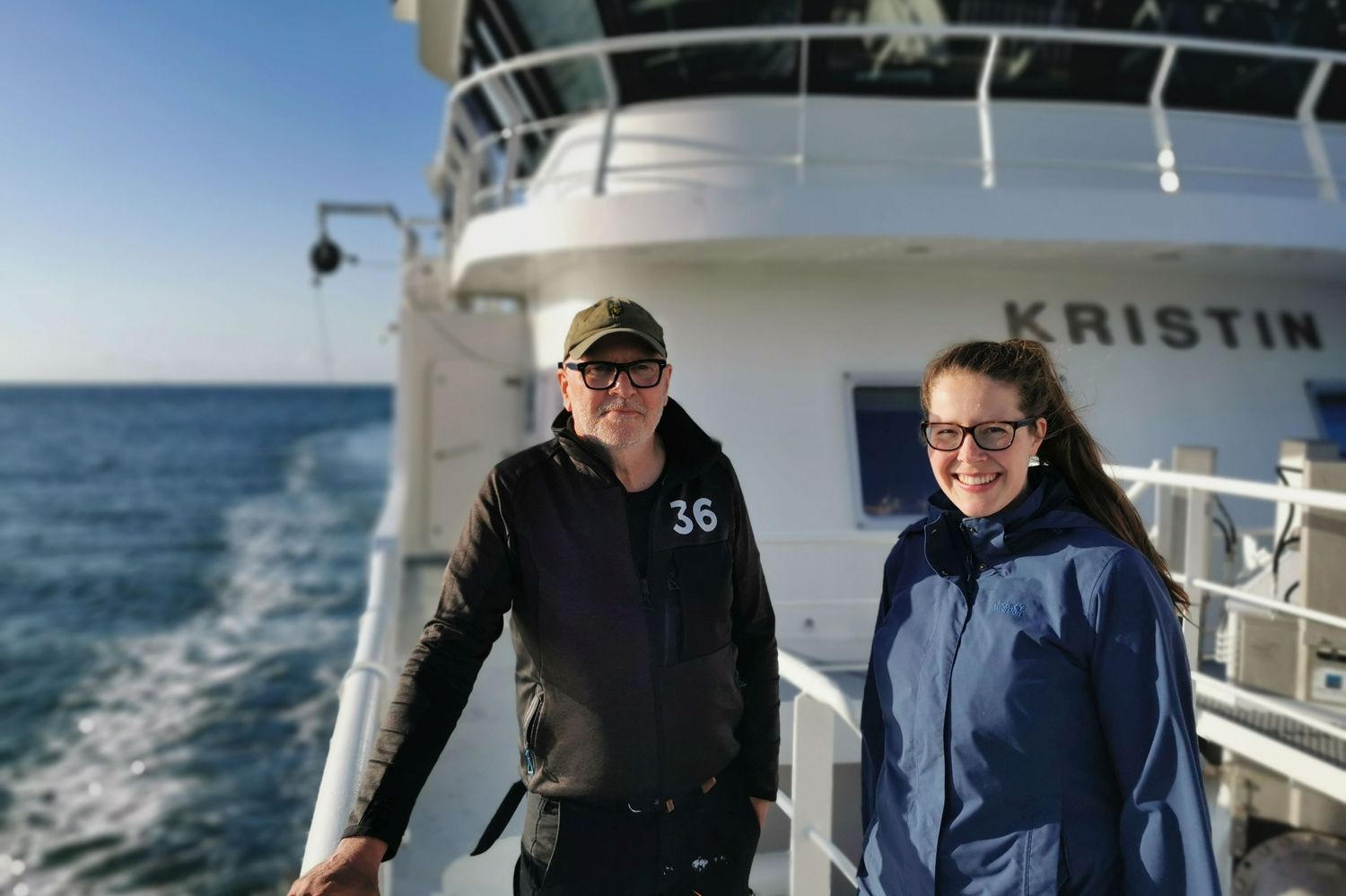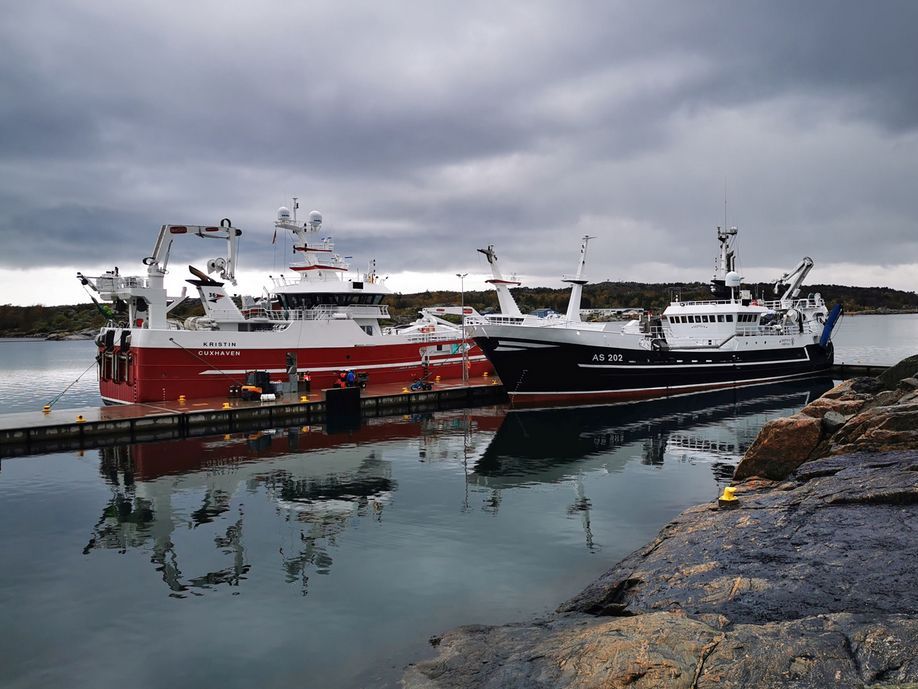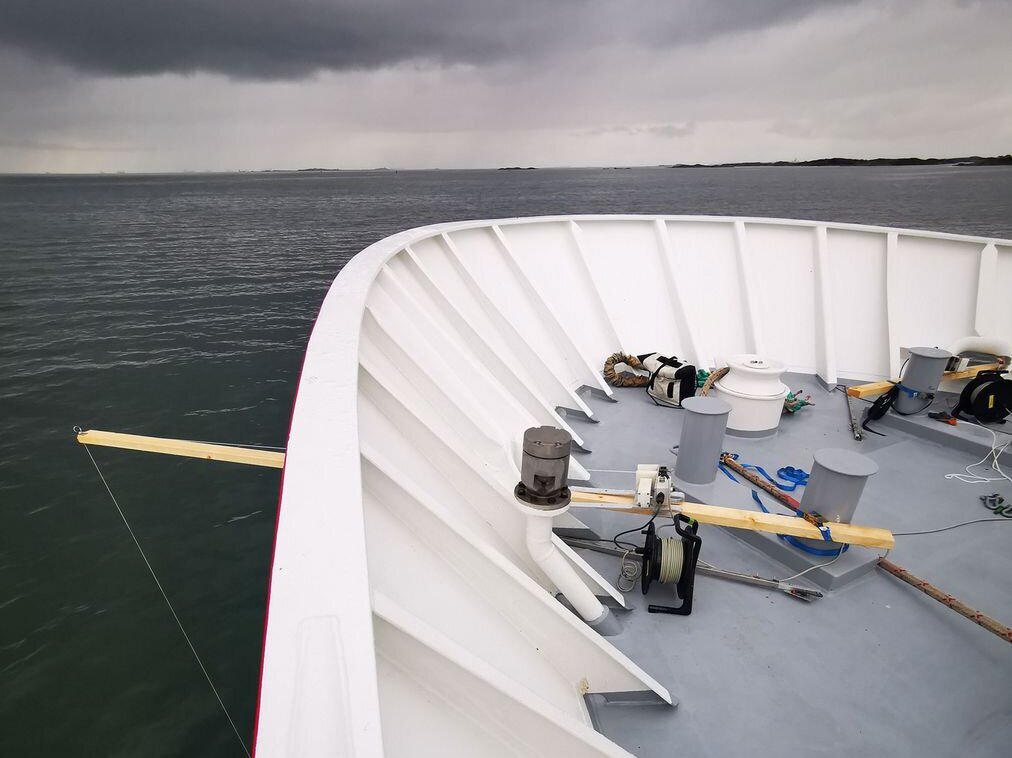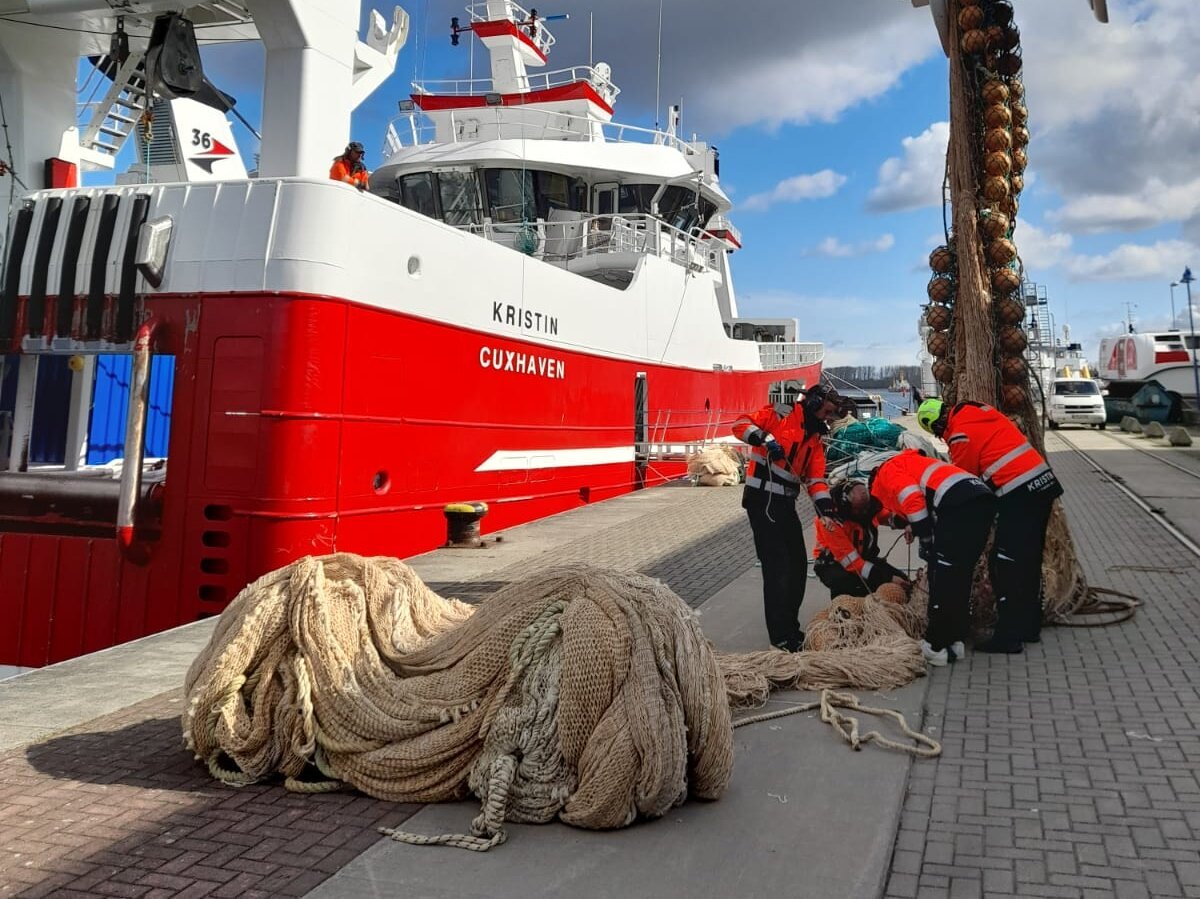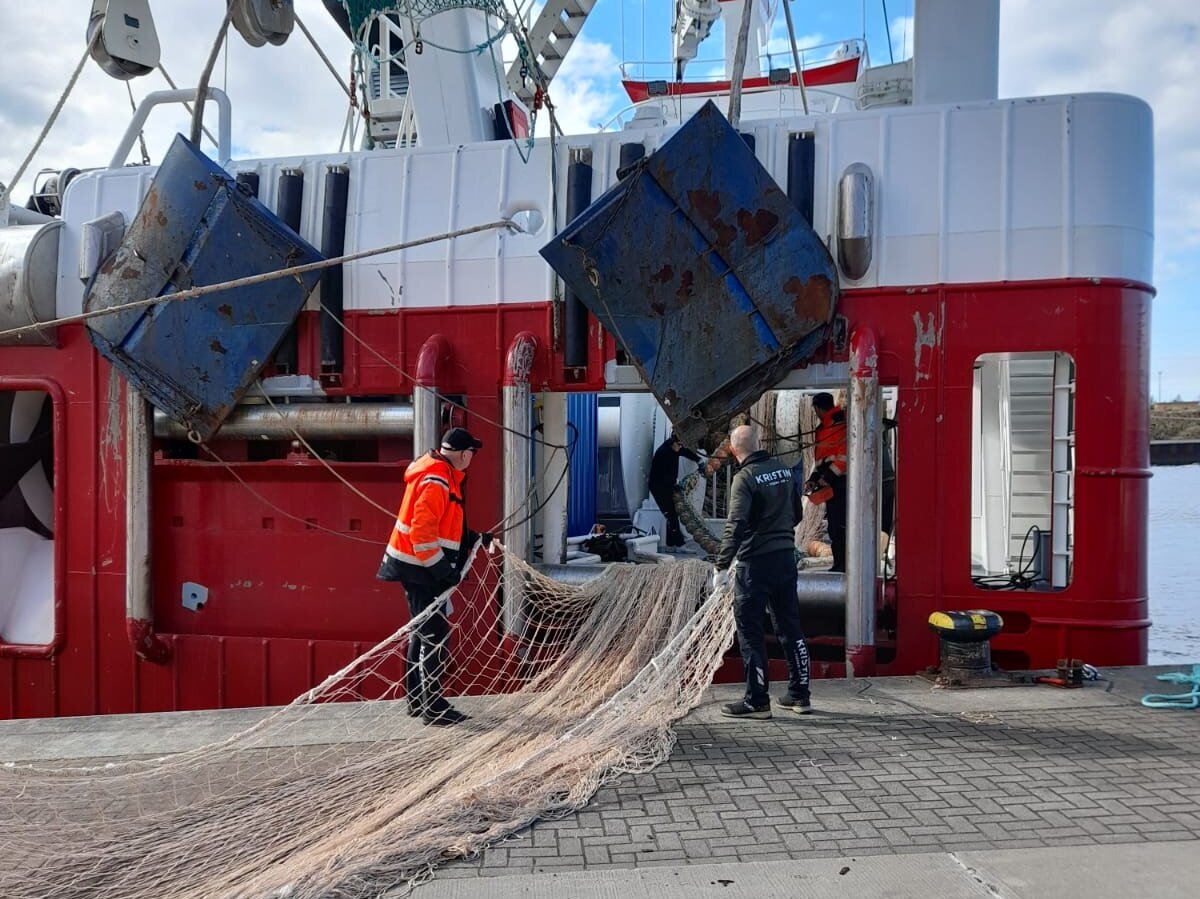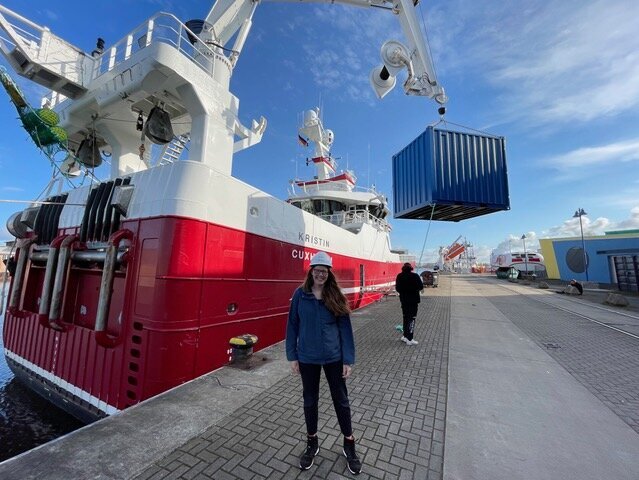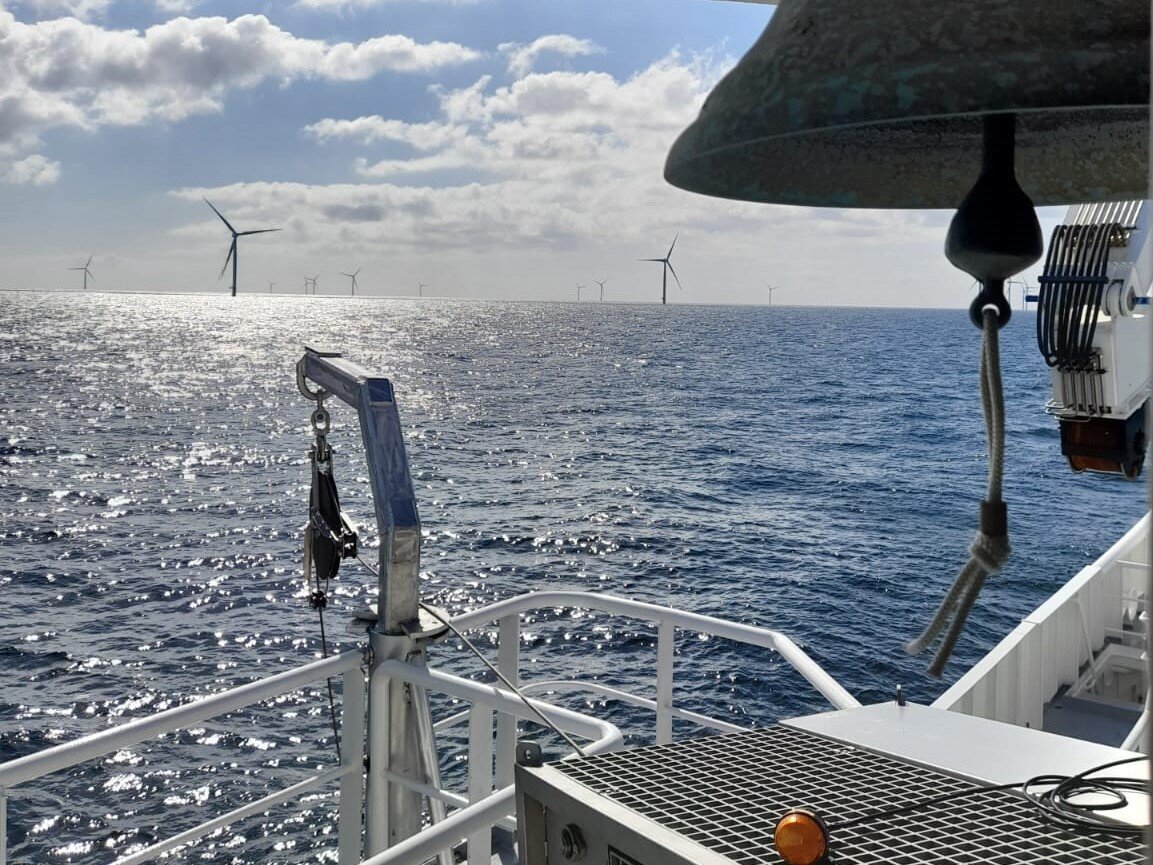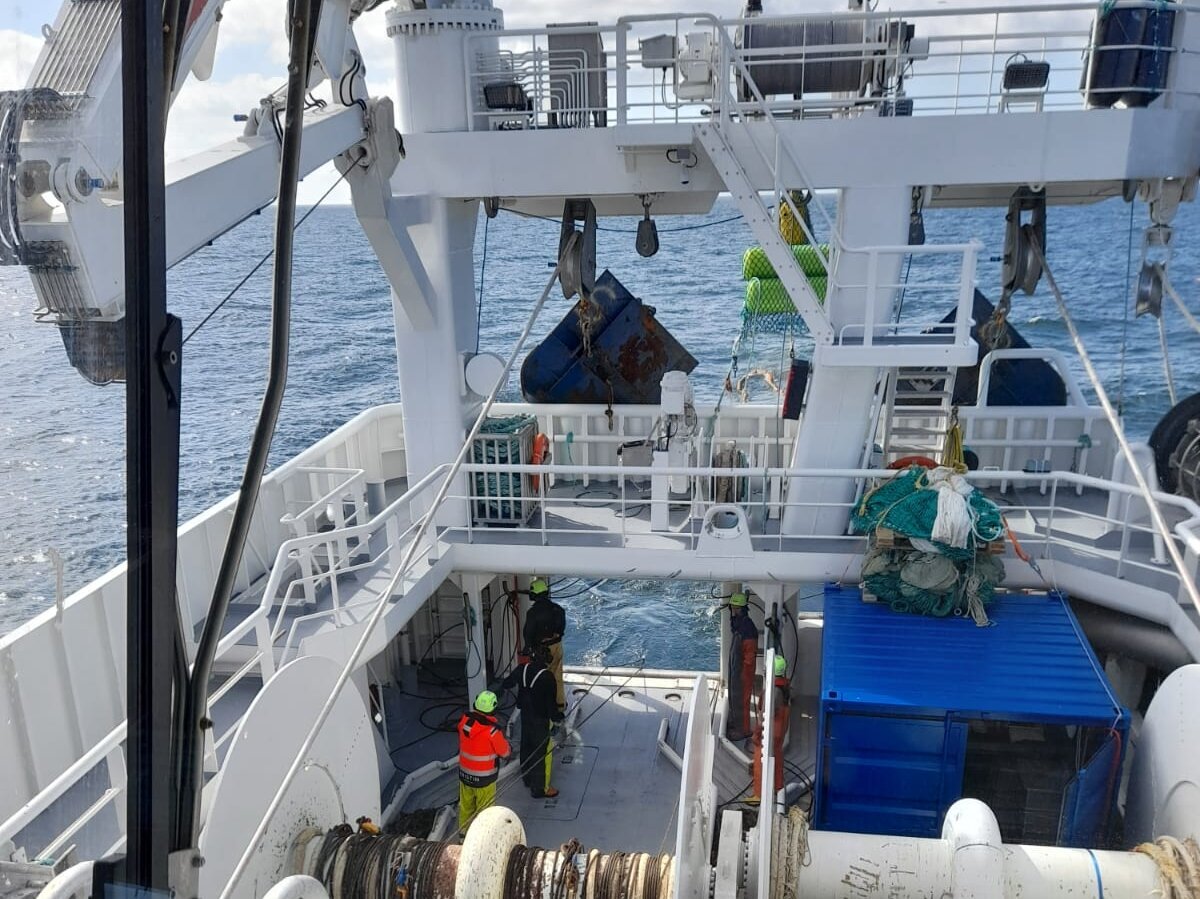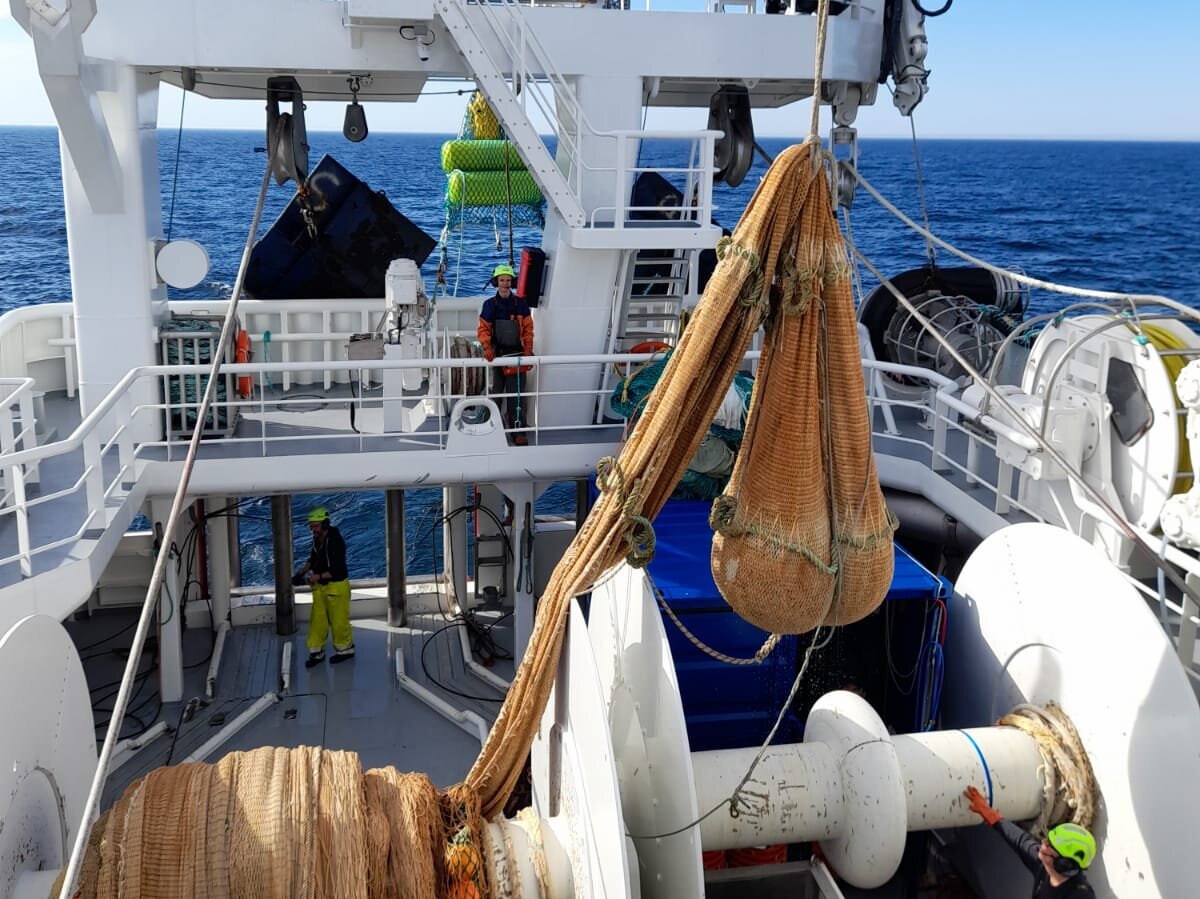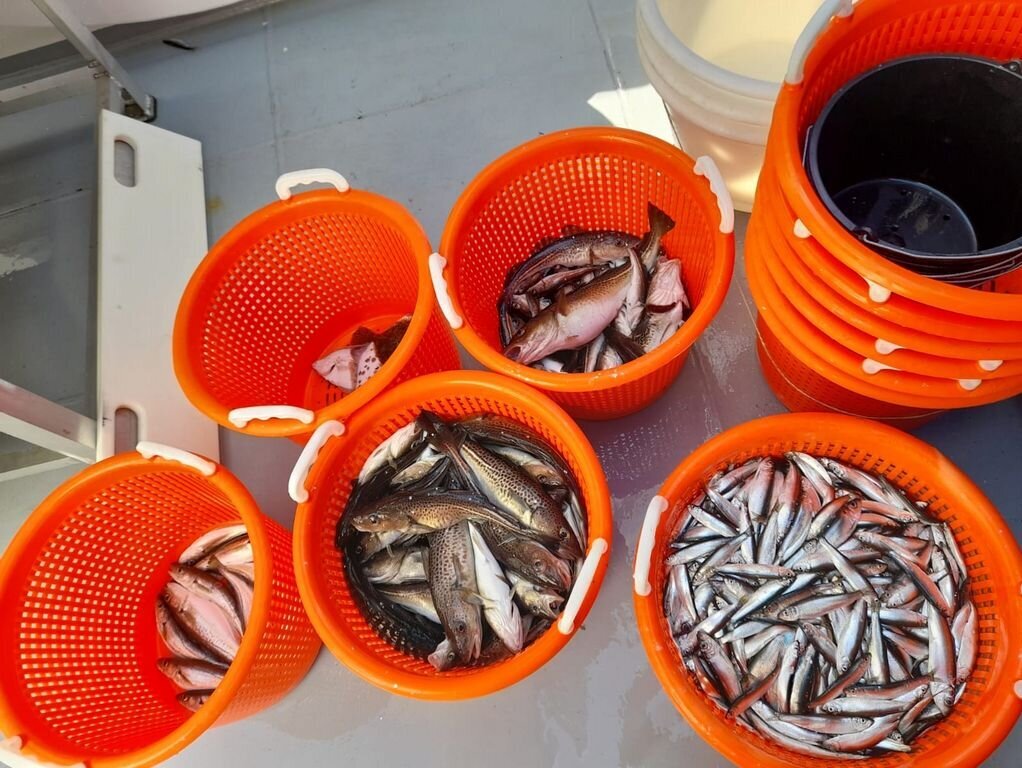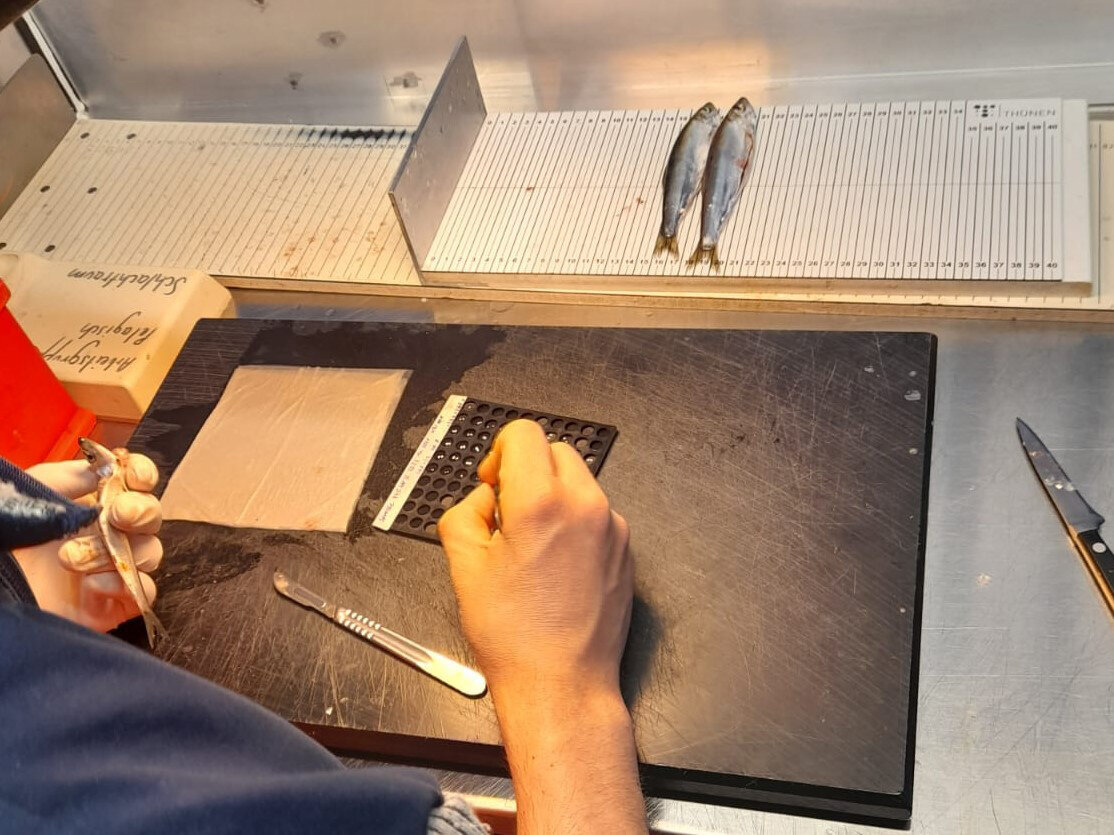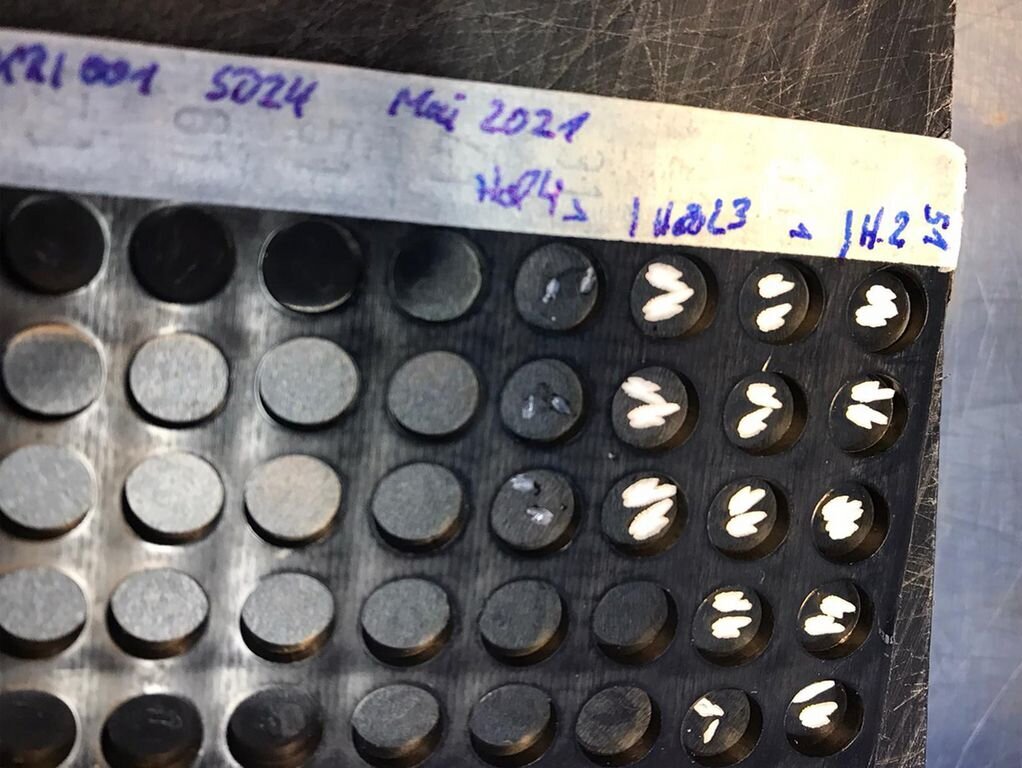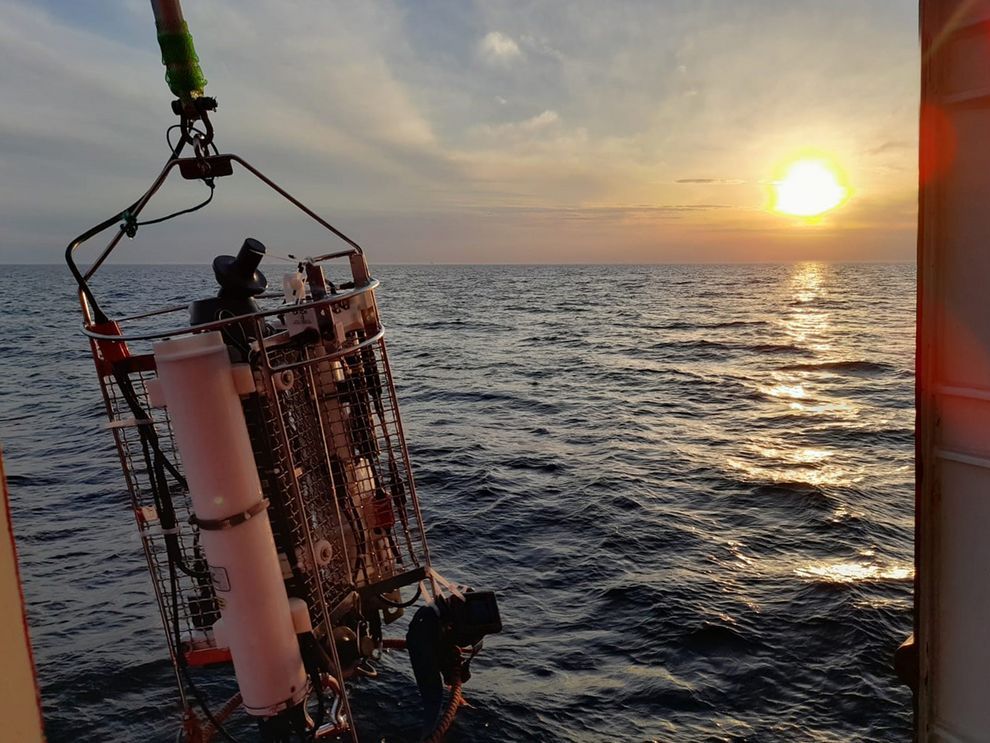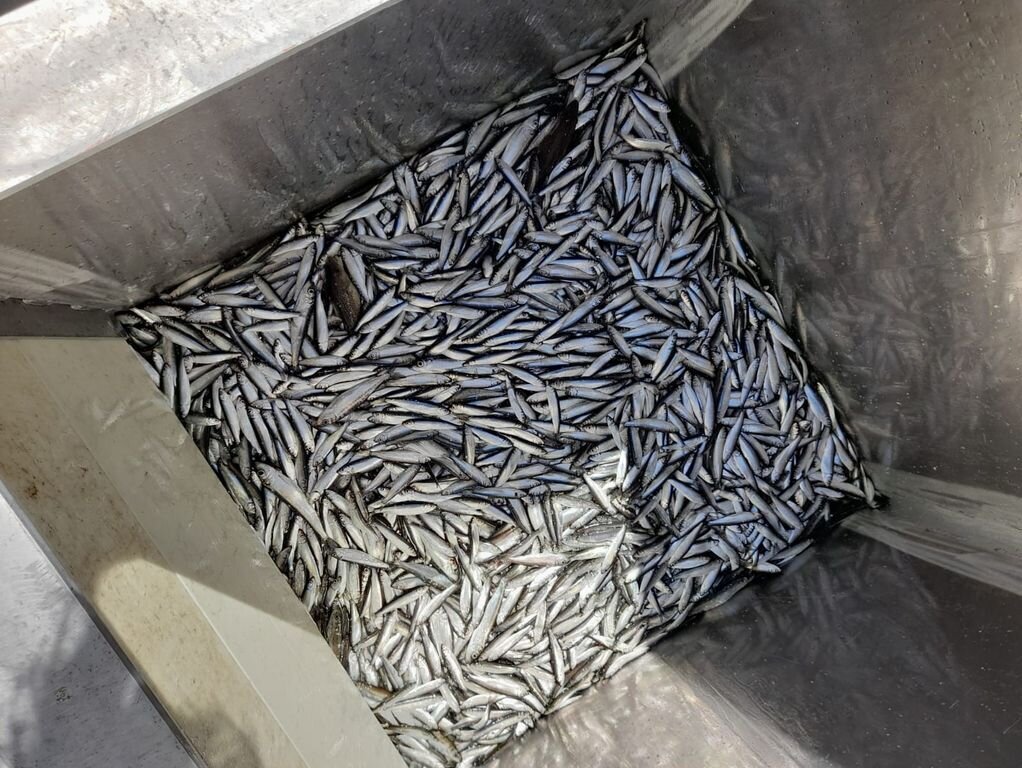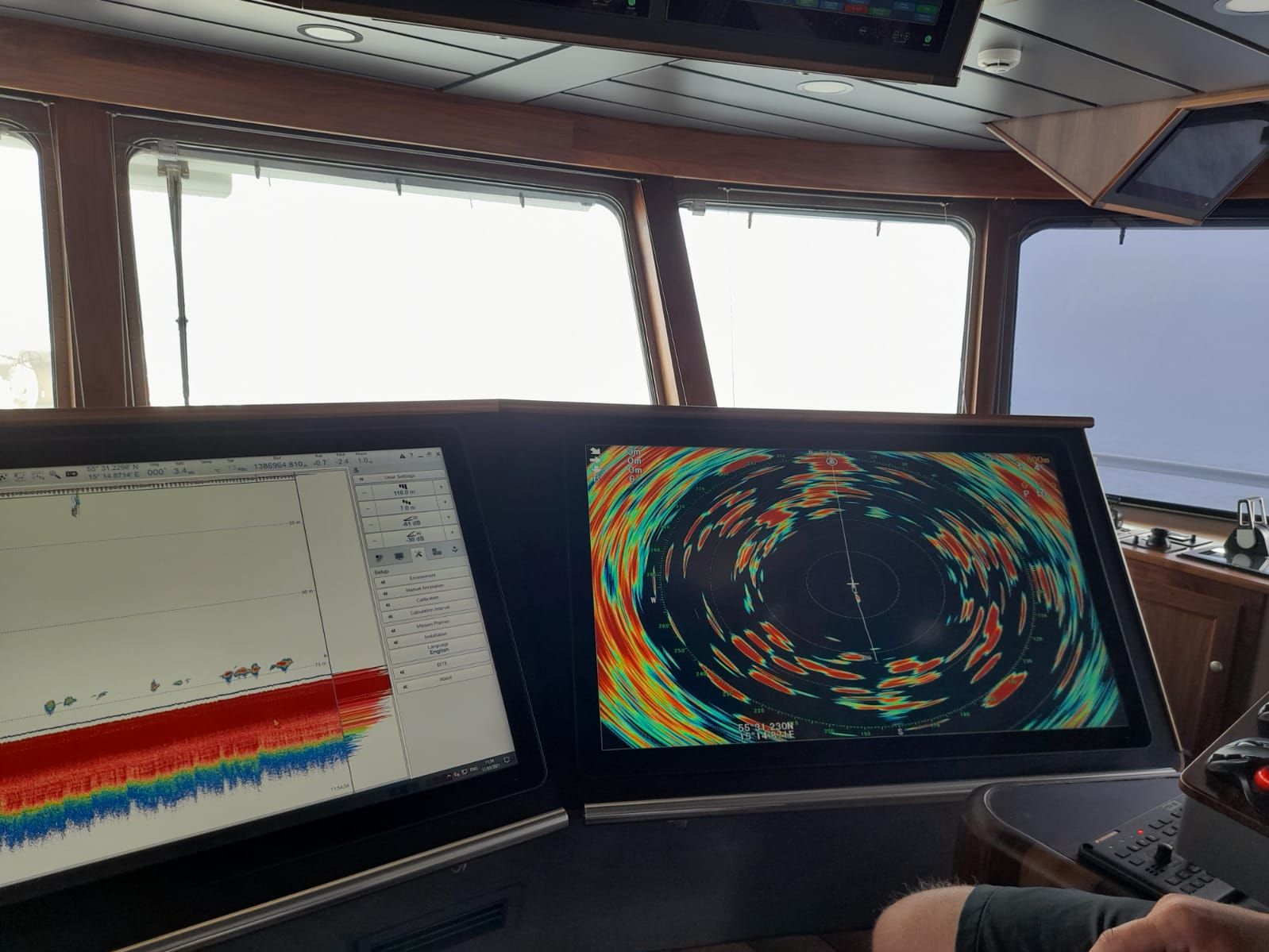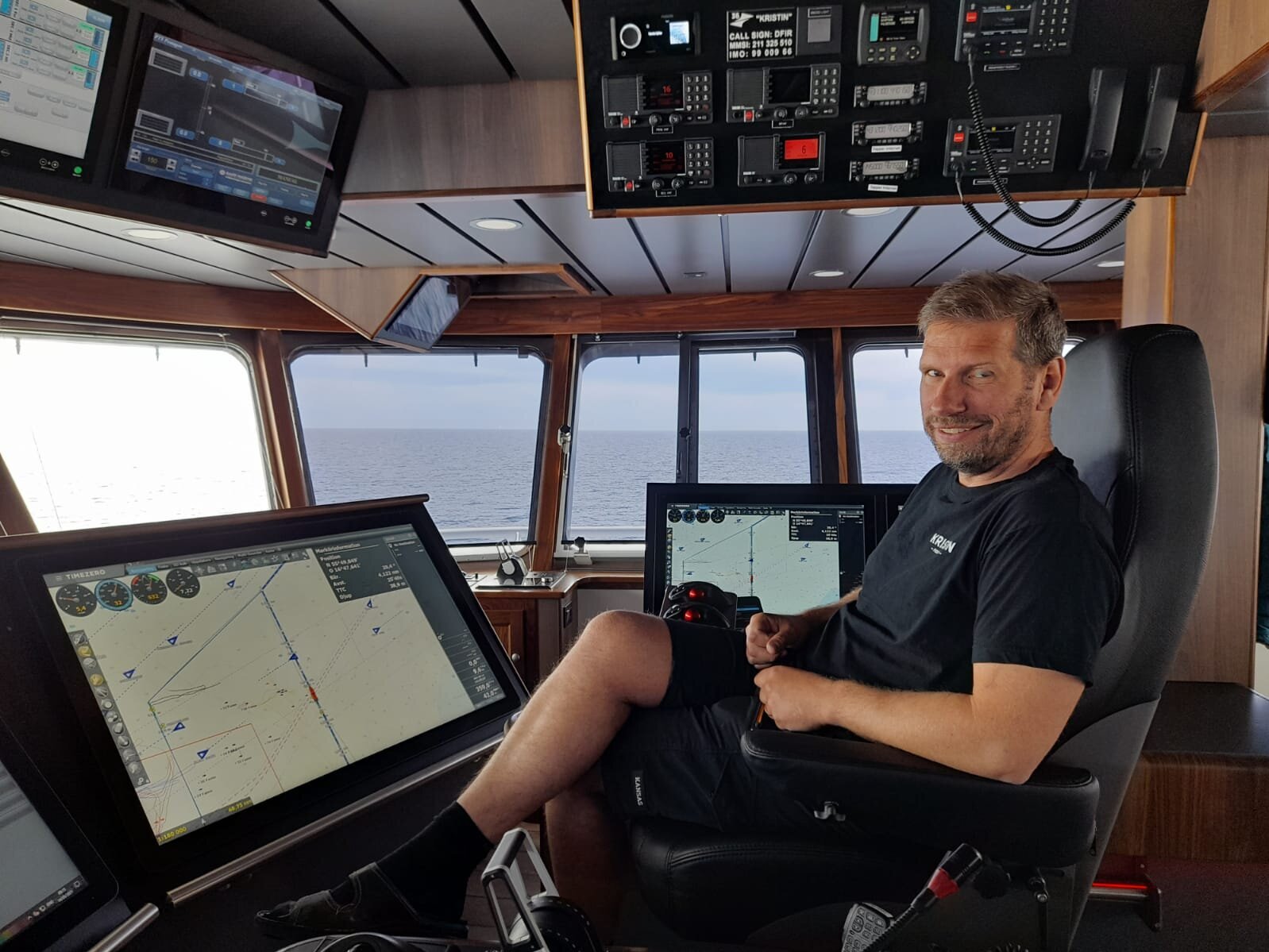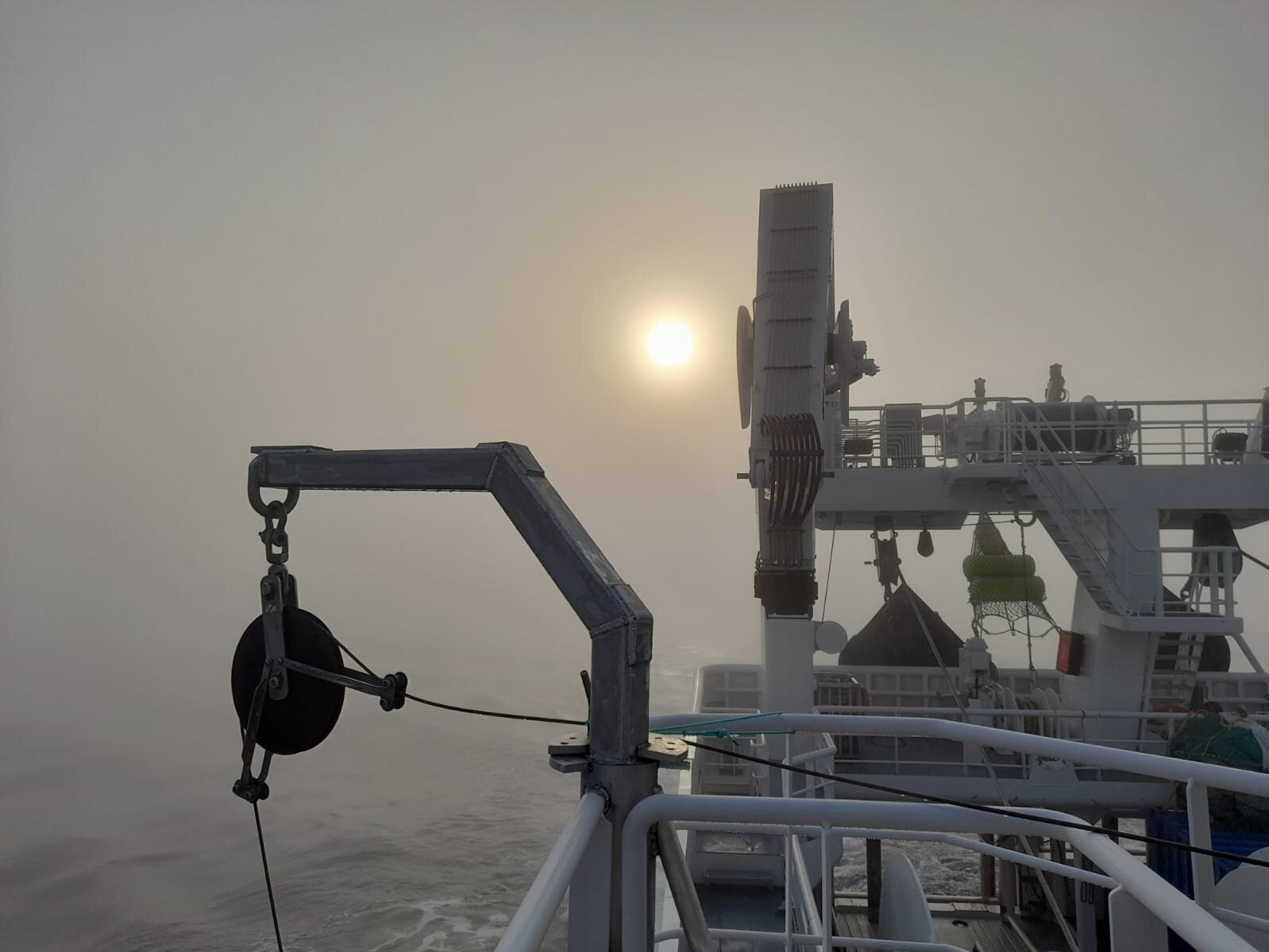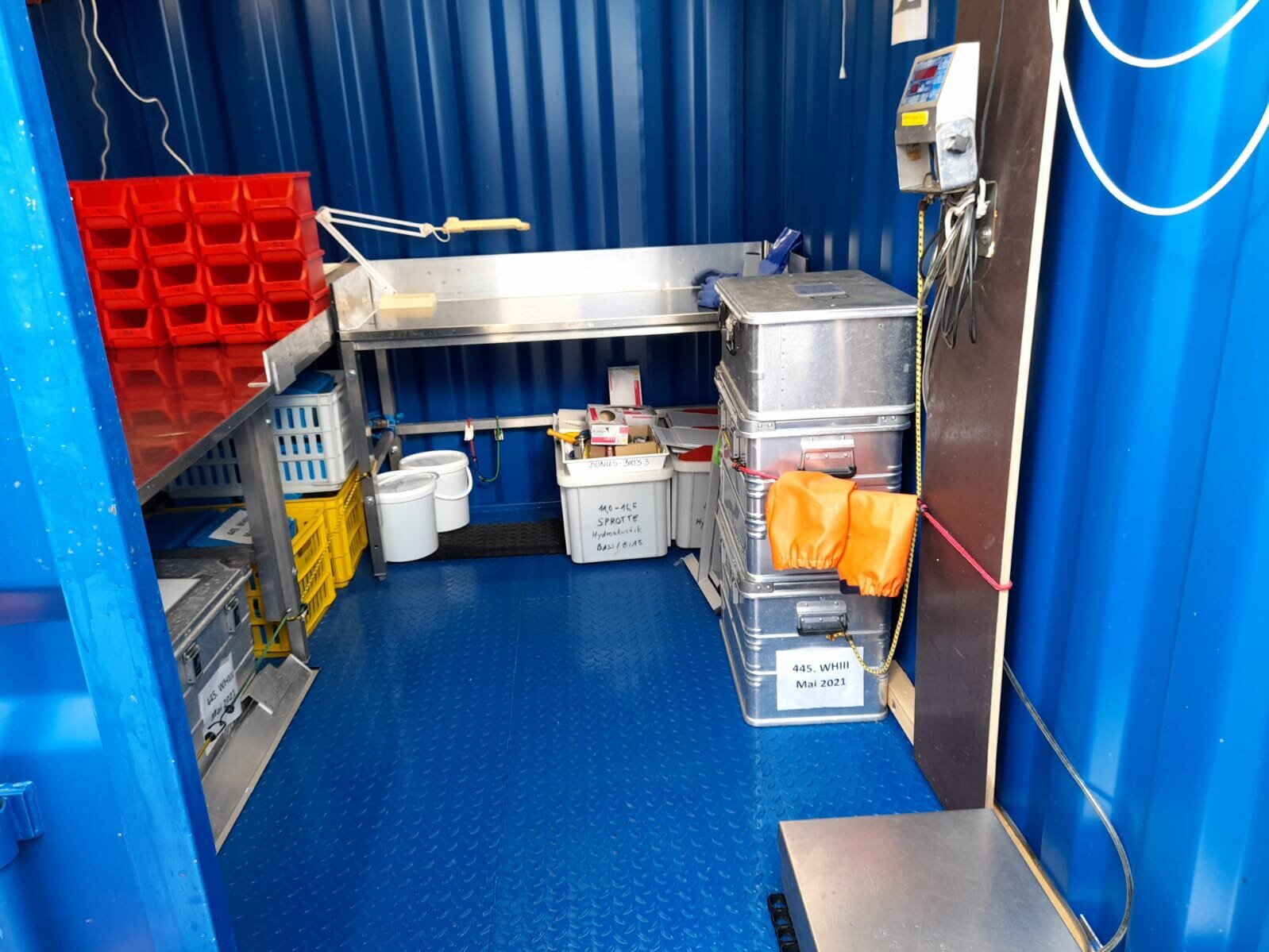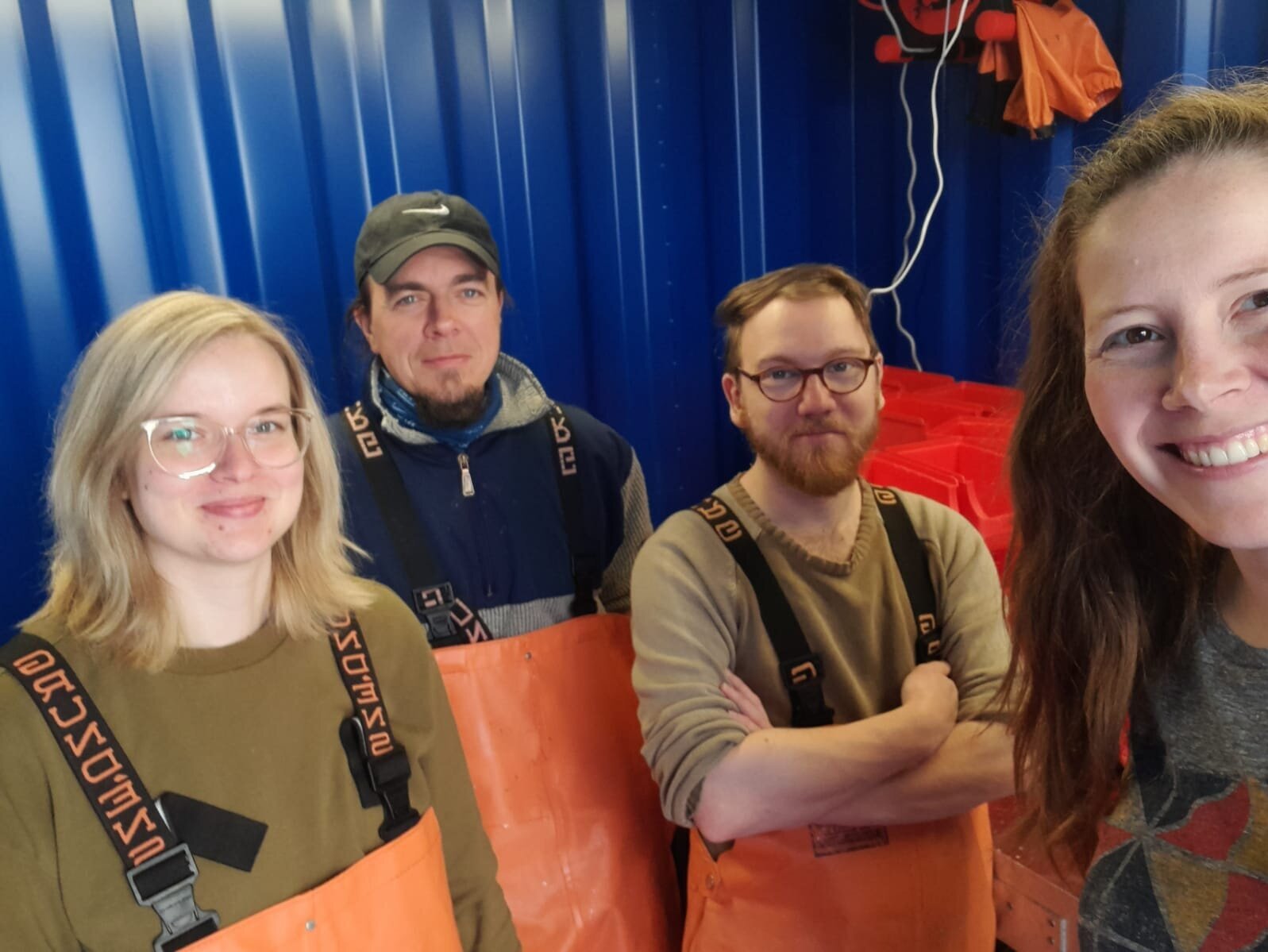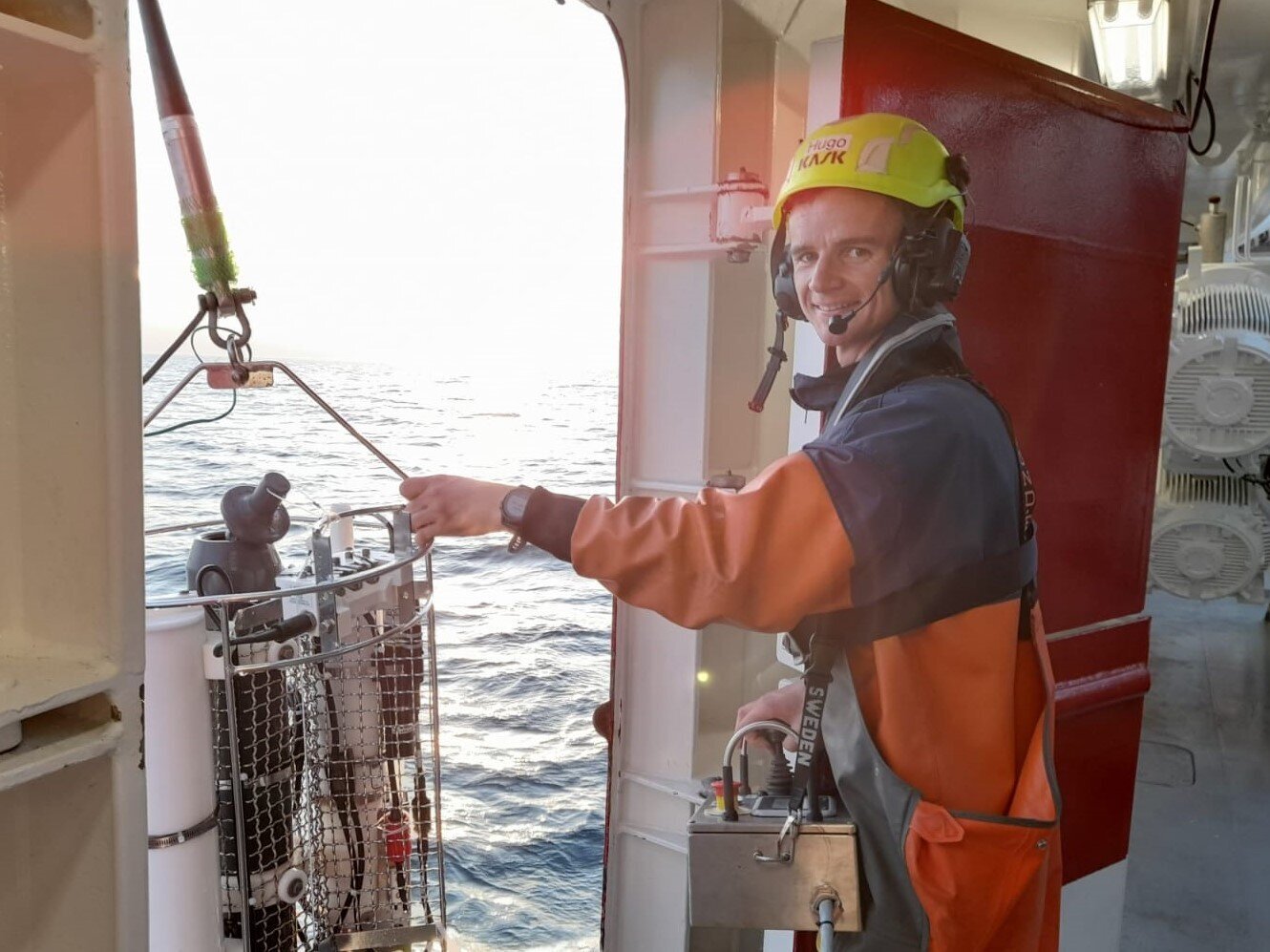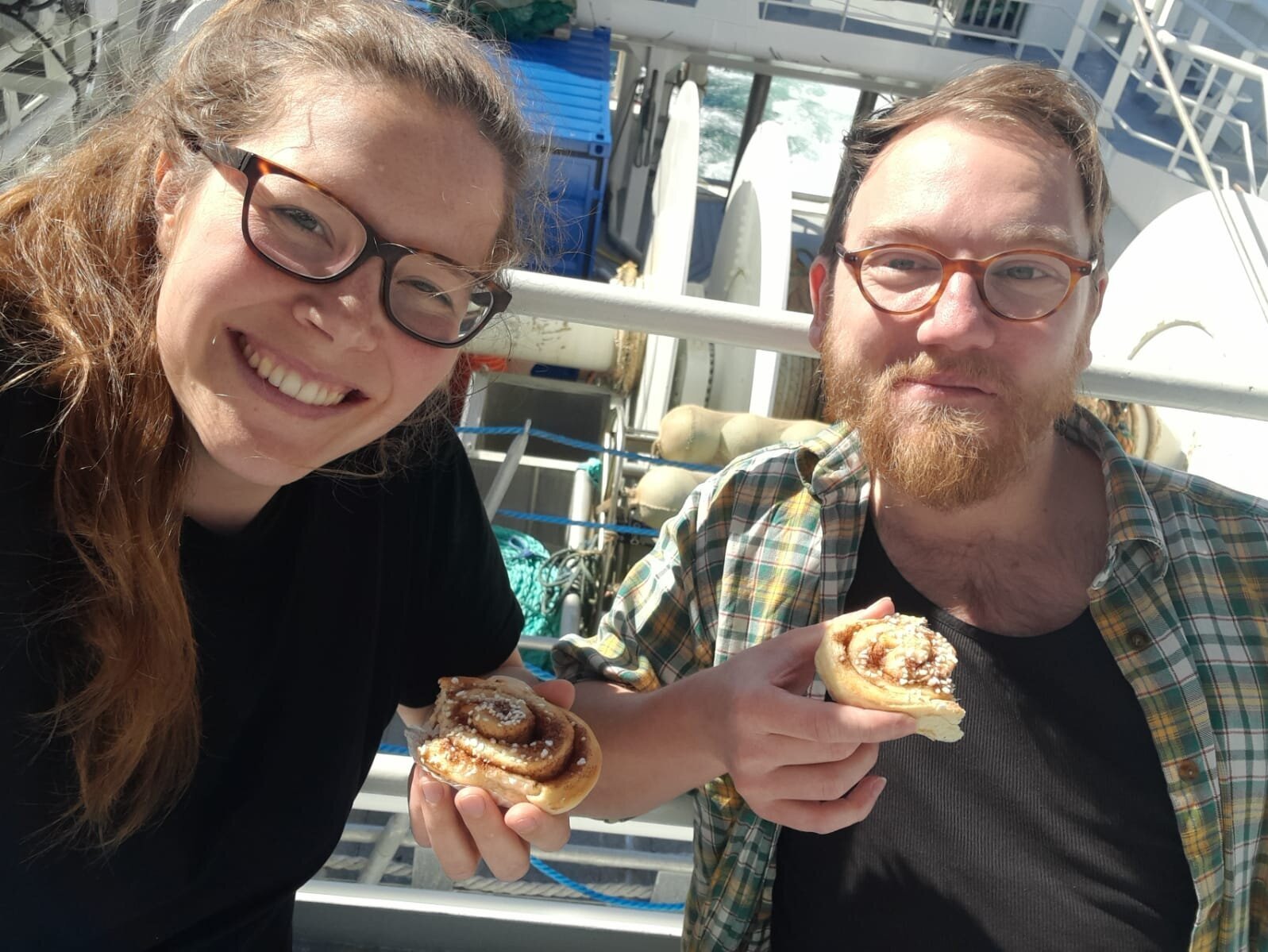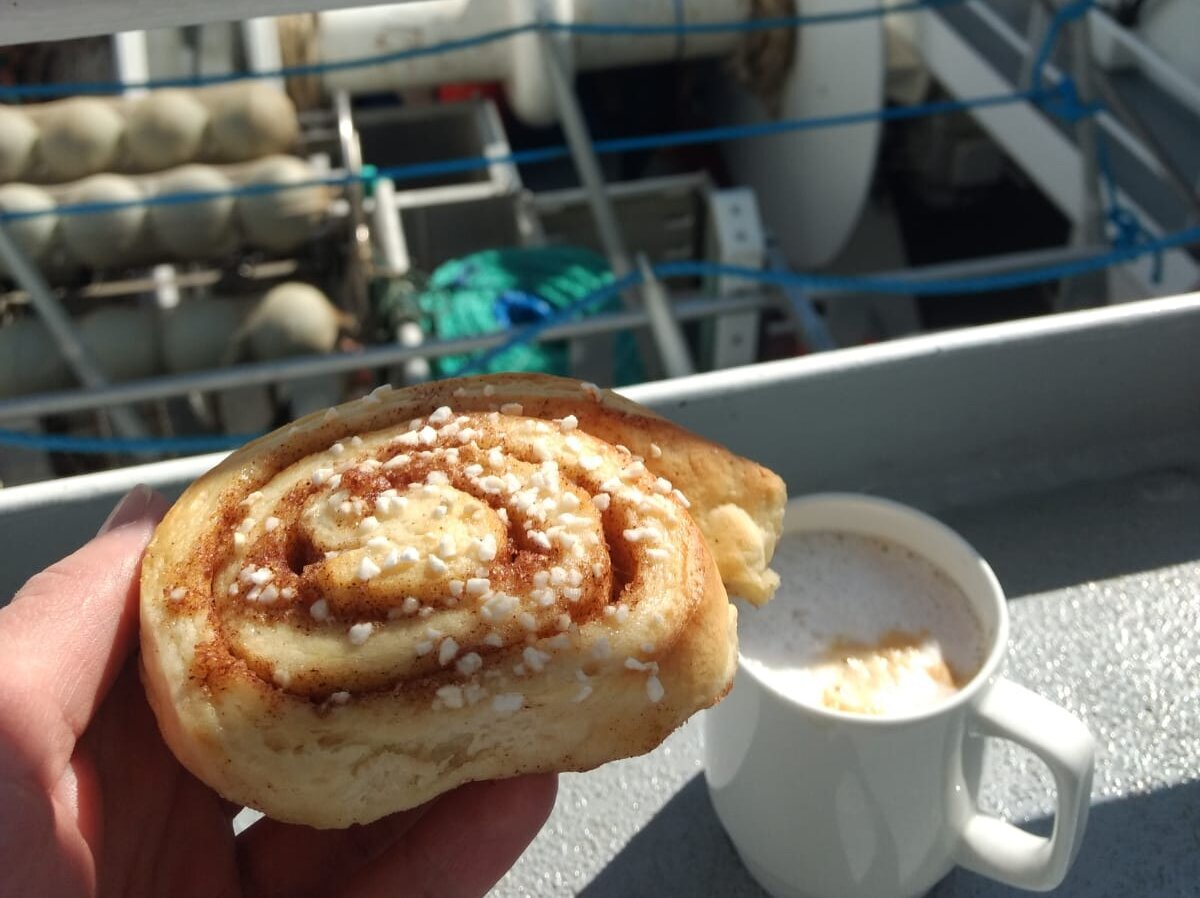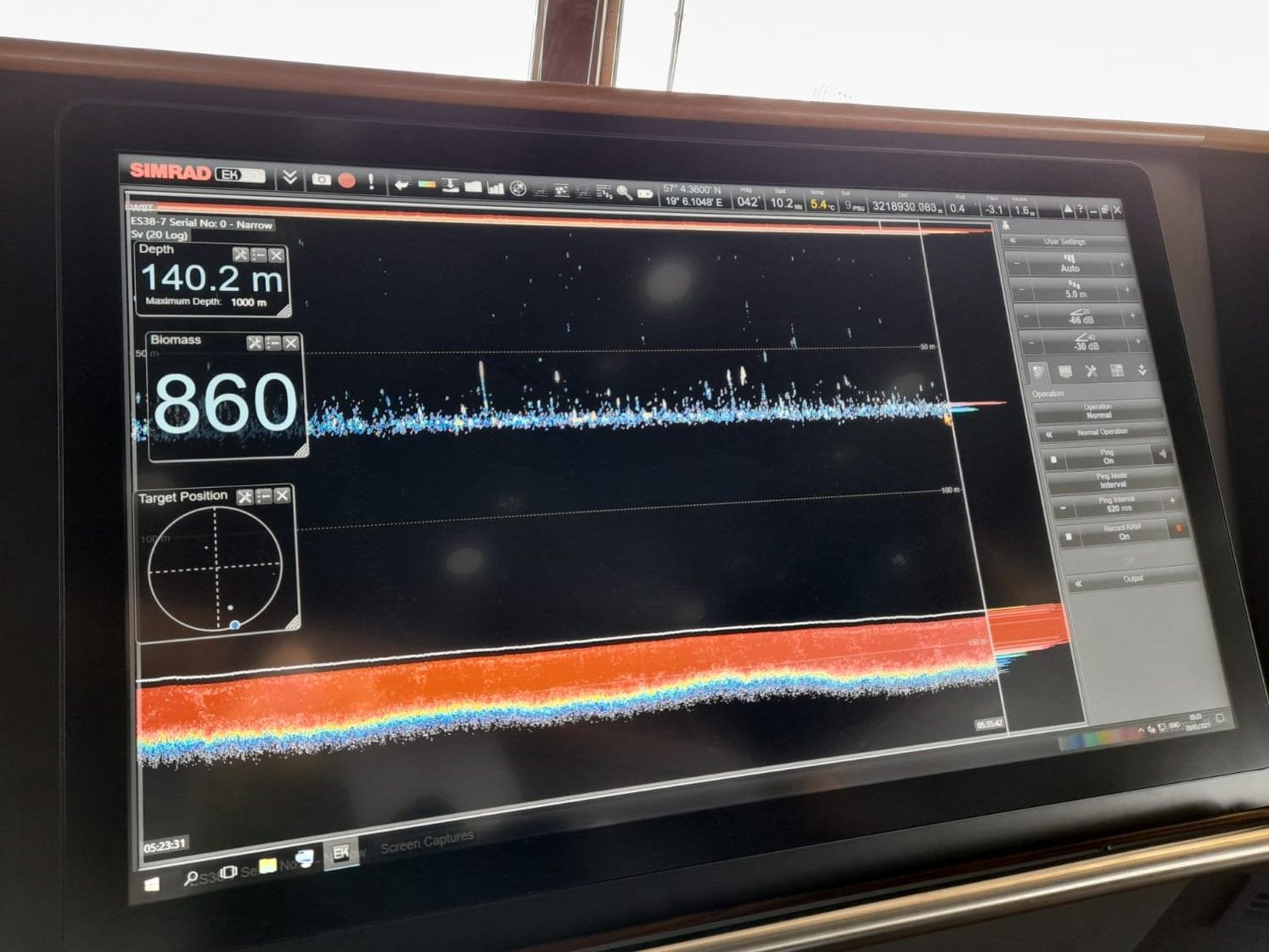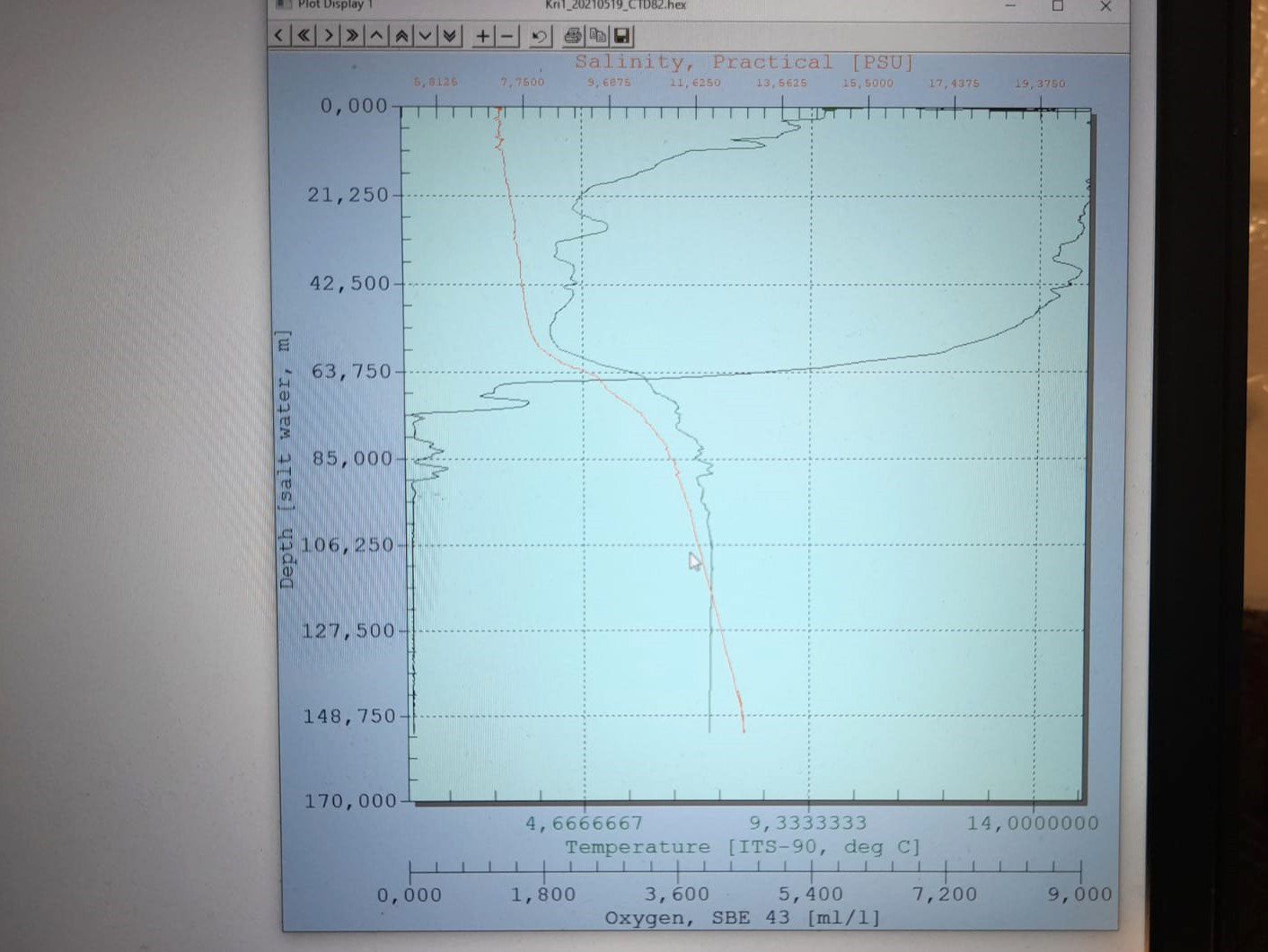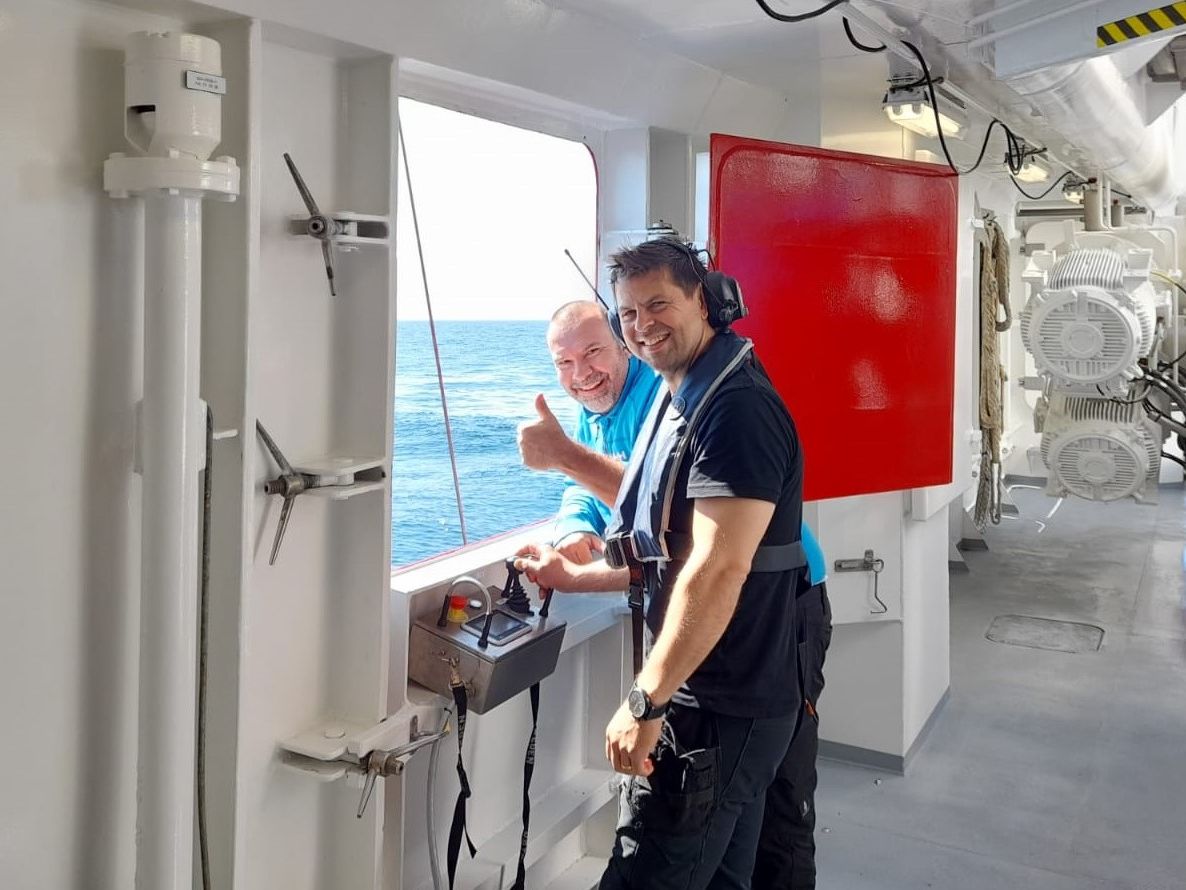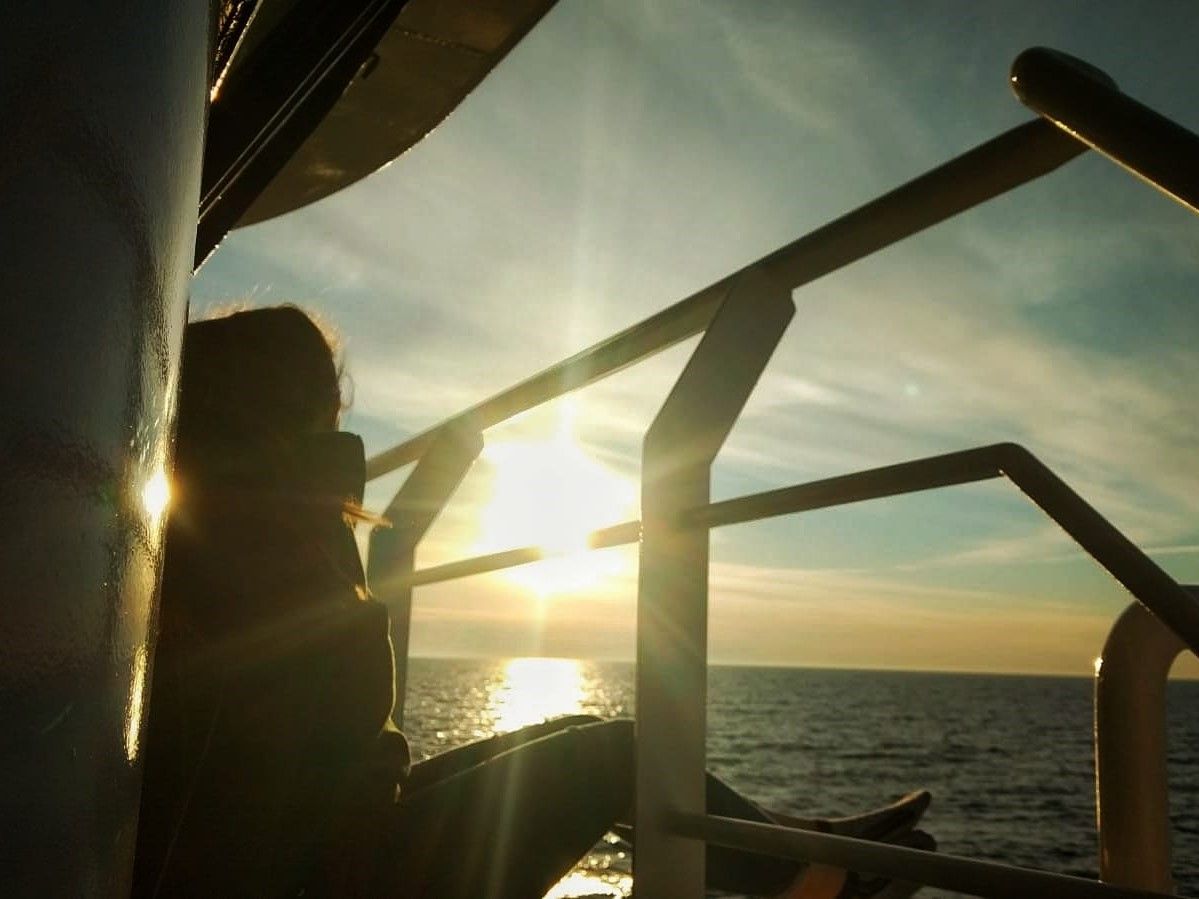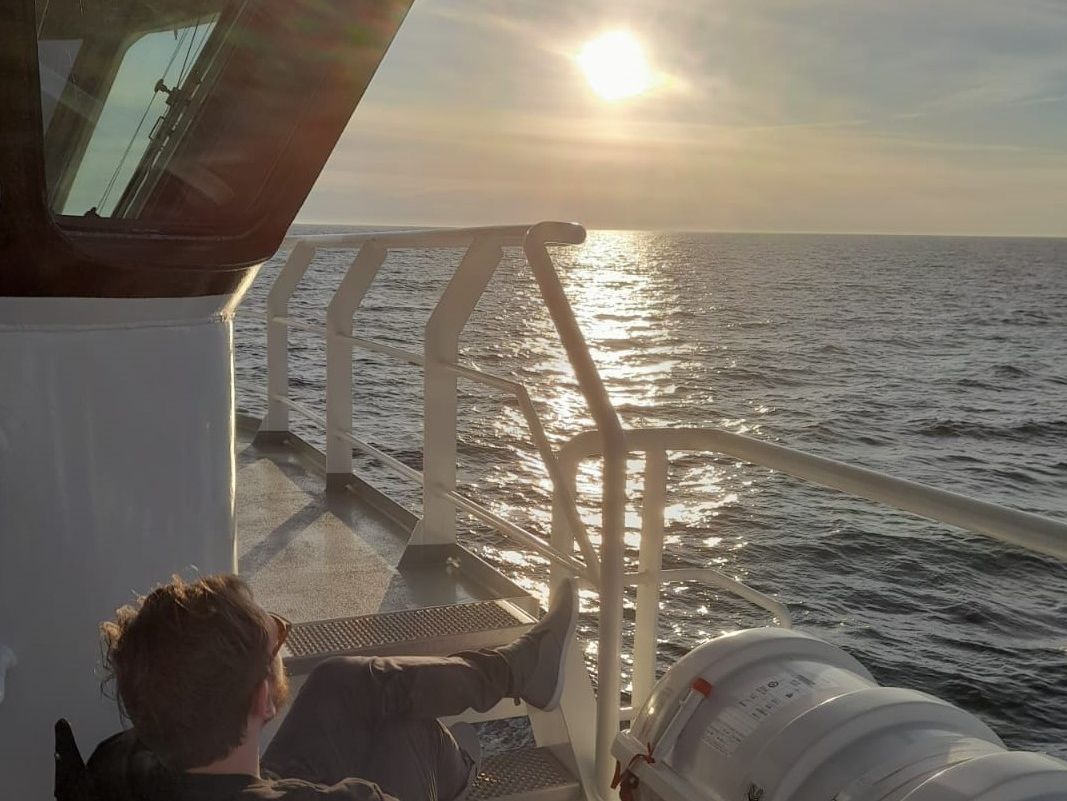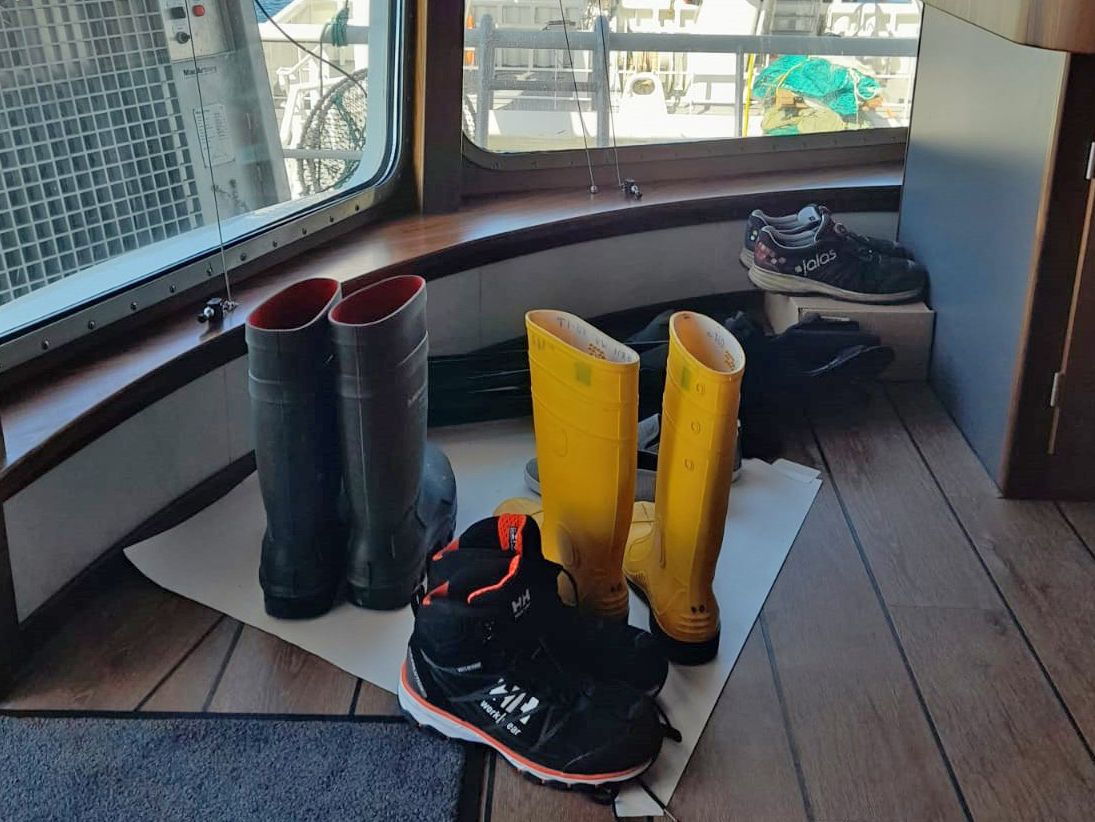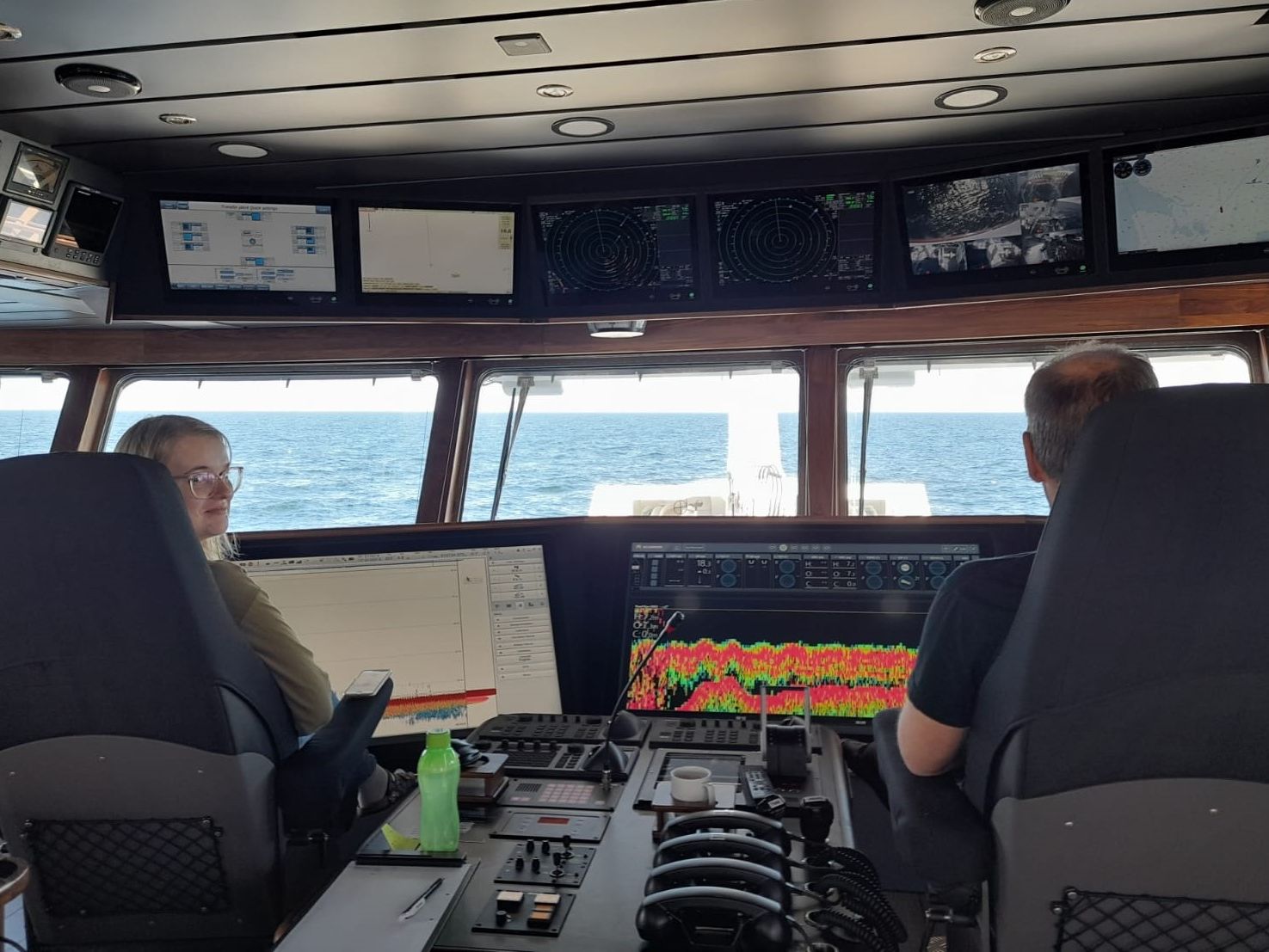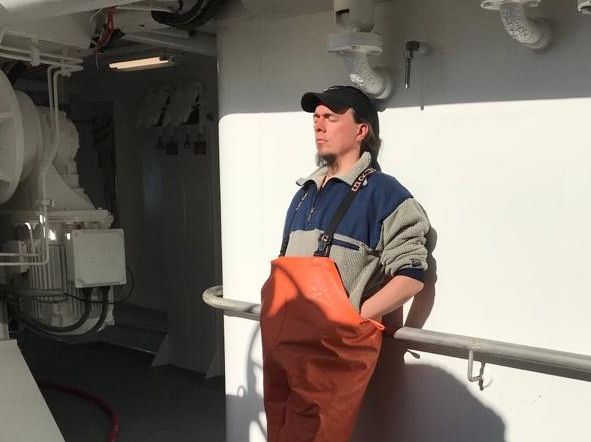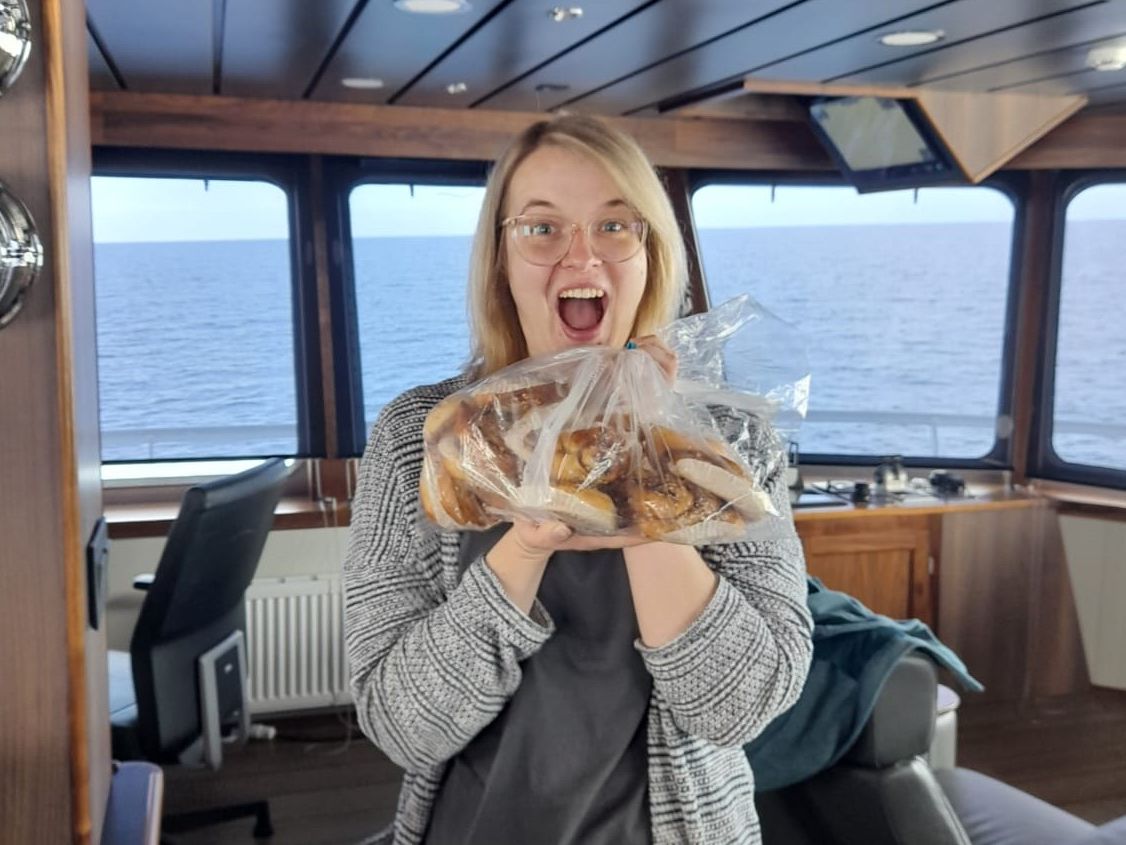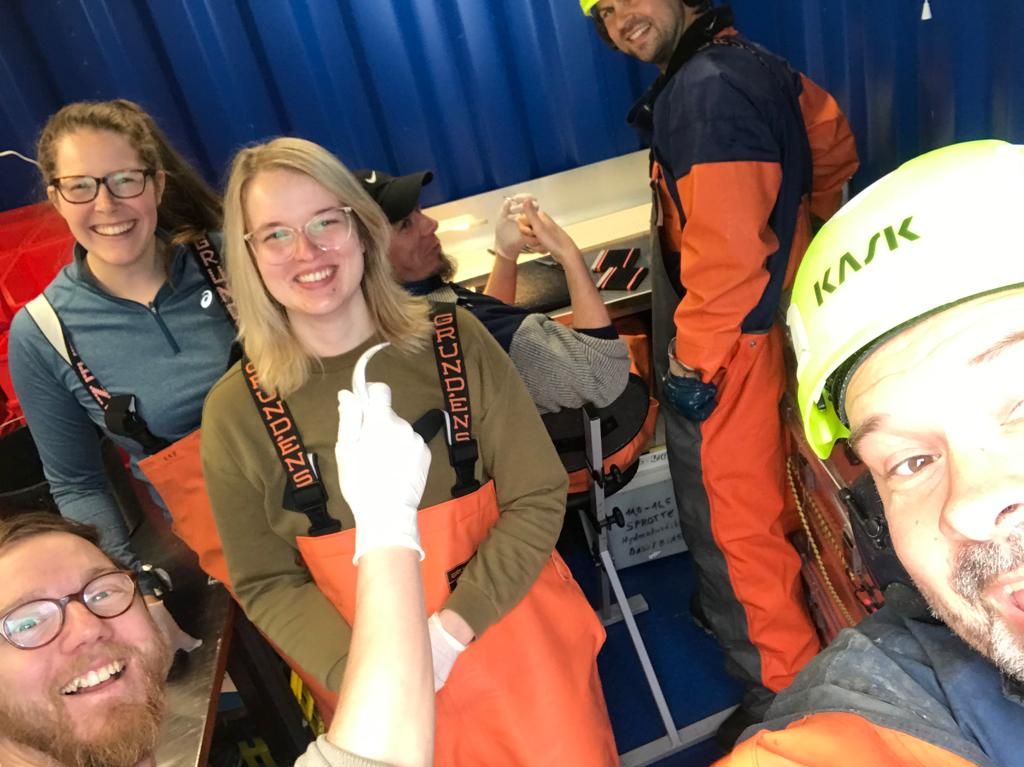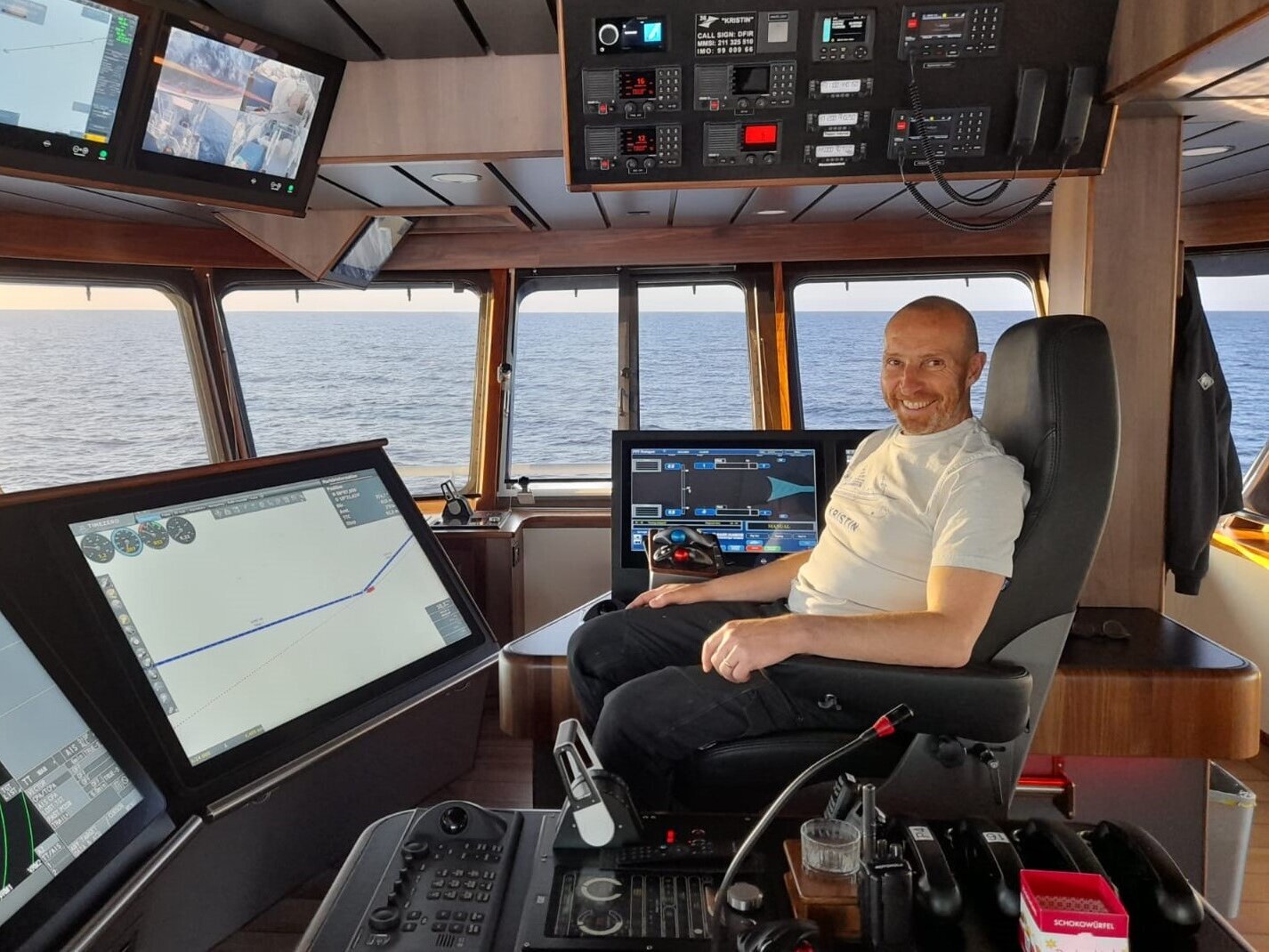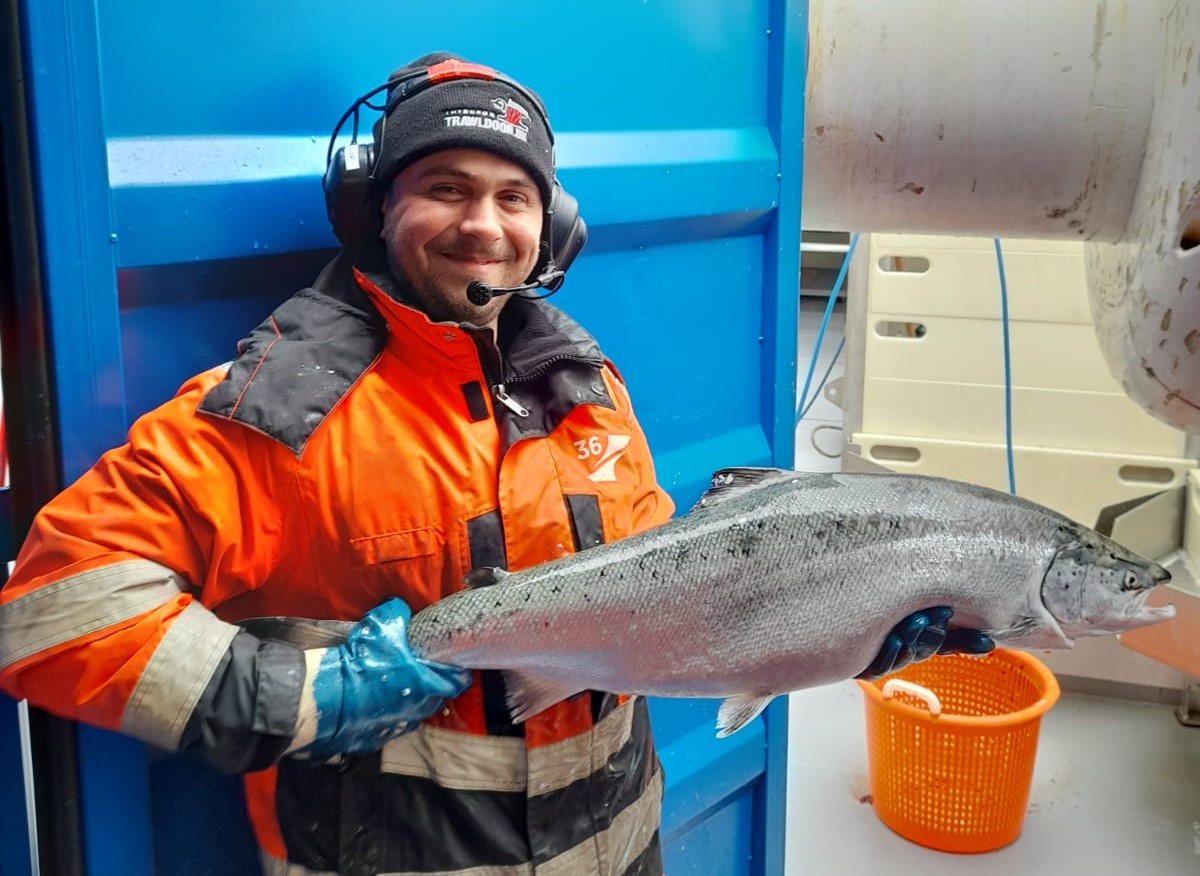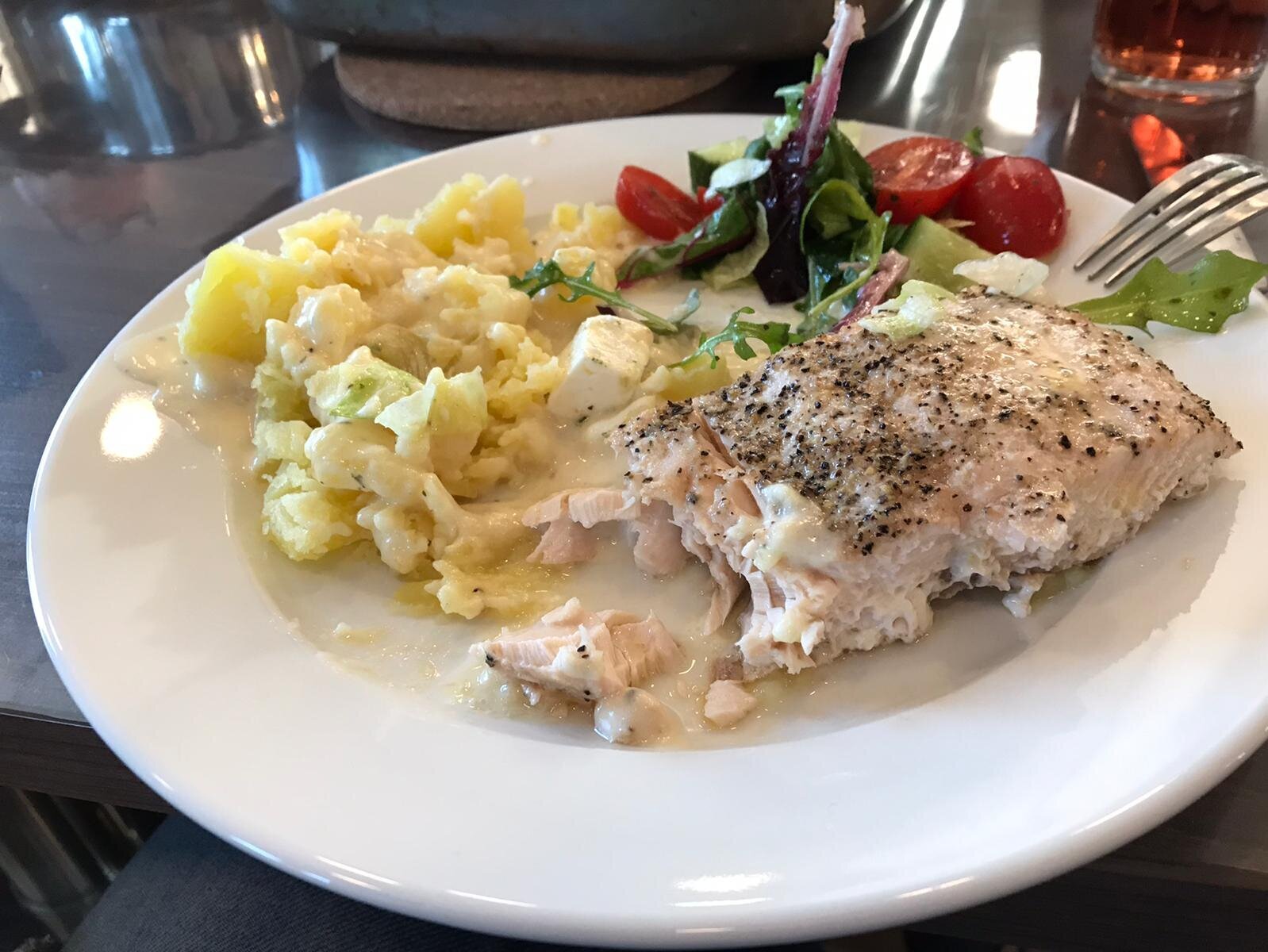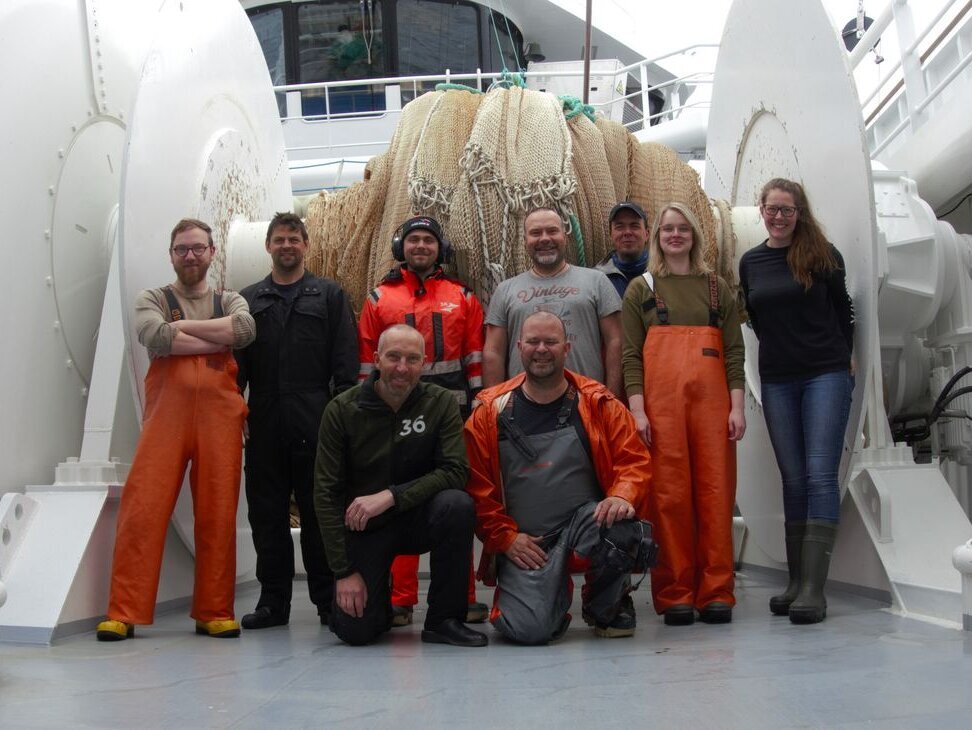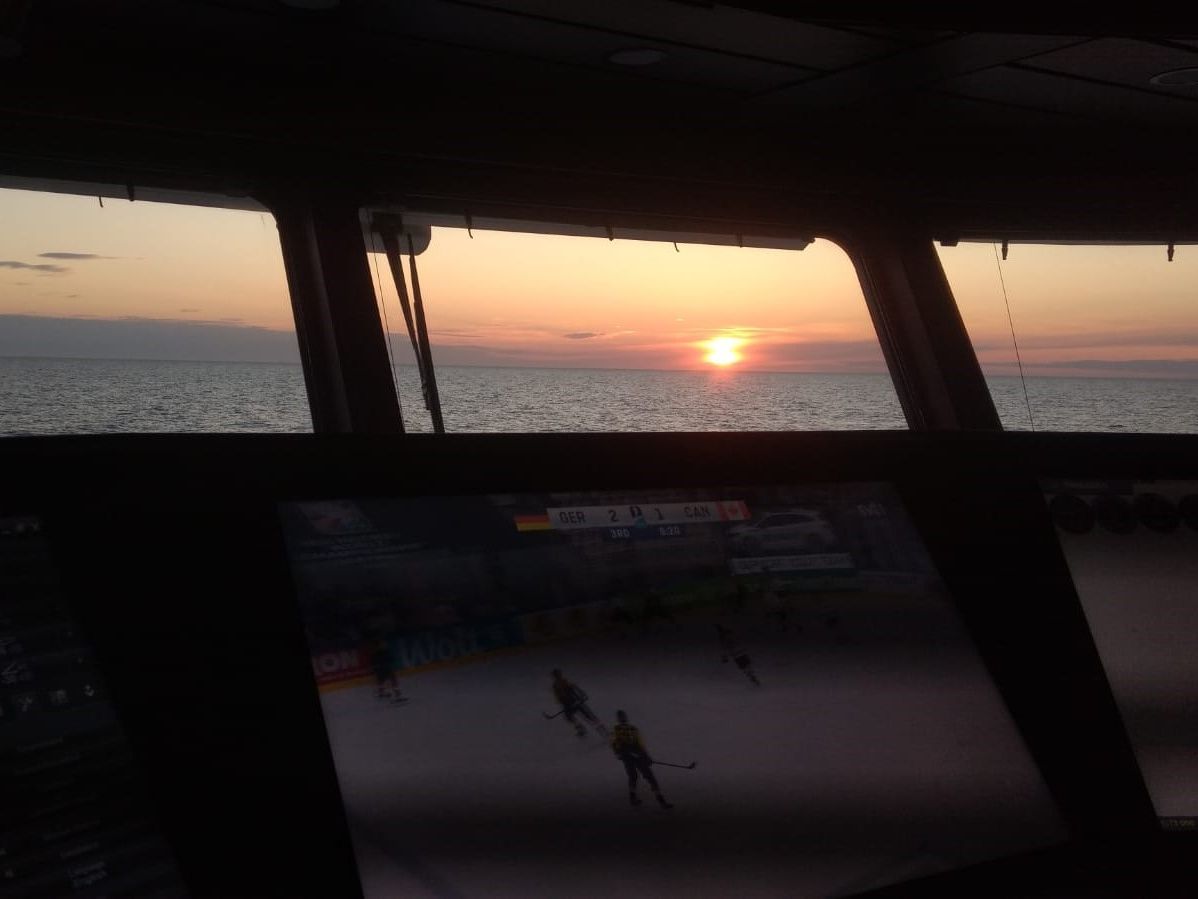Sea blog
Kristin: 1st cruise for the Thünen Institute
Stefanie Haase and the team
Duration: May 7th to May 28th, 2021
Area: Baltic Sea
Purpose: Baltic Acoustic Spring Survey (BASS)
Cruise leader: Stefanie Haase, Thünen Institute of Baltic Sea Fisheries
Almost exactly one year ago we returned from our Sprat Acoustic Survey with the pelagic fishing trawler "Kristin". Over the summer of 2021, we analyzed the data and then presented it to the relevant International Council for the Exploration of the Sea (ICES) working groups in the spring of 2022. Because the Kristin was able to fill in so quickly for the failed "Walther Herwig III," we prevented an interruption in the time series that would have been fatal for the stock calculations of sprat in the Baltic Sea.
But even now, a year later, the work is not yet complete. When an acoustic survey is conducted with a different vessel, the continuity of the time series may be altered. Specifically, this means that different vessels may have different scouring effects on schools of fish, for example, if they are noisy differently. To quantify this and correct for it with a coefficient if necessary, intercalibrations are performed between vessels.
During intercalibration, the two vessels steam in formation over schools of fish and measure them using the echo sounder. All settings are exactly the same as for the classic hydroacoustic survey. Alternately, the two vessels take the lead so that at the end we can compare whether the measurements differ.
So, after we had completed all transects of the Sprat Hydroacoustic Survey 2022 with the "Walther Herwig III" (456th voyage), we met with the "Kristin" in the Bornholm Basin early in the morning of May 22, 2022 to hydroacoustically measure schools of fish in formation for two days. The distance between the two ships was only 400 m and they steamed just far enough to the side so that the rear ship did not sail in the screw water of the leading ship. At the same time, we were in continuous radio communication to indicate maneuvers in time to guarantee a successful measurement. Every four hours, the rear ship then overtook the front ship to take the lead itself.
The cooperation between the two ships was terrific and so we were able to say goodbye to each other on the evening of May 23 with the simultaneous sounding of the ship's horns. The "Kristin" started her journey home and the "Walther Herwig III" steamed towards Rostock to let the science descend there after three weeks of successfully completed survey program. Back on land, the recorded data will now be compared to see if there are any differences. If necessary, the measurements of the last year with the calculated coefficient for the "Kristin" will be adjusted to the long time series of the "Walther Herwig III" accordingly.
In the following the sea blog entries of the trip from the year 2021 come in chronological order.
In order to prepare the vessel Kristin for the BASS Survey, a small team of four people, including myself as cruise leader, went to the shipyard in Skagen (Denmark) on the 2nd of May , where Kristin was lying for warranty acceptance. Because we were already accommodated on board, we did not have to go into therequired Corona quarantine: seafaring personnel on their way to the ship are exempt.
The next day, a Monday, we started with the preparations for our survey. In order to put the scientific acoustic system into operation, our technician Ulf Böttcher had to solder numerous connections. We also installed our wide band transceiver in the ship's system. This allows us to send acoustic signals into the water column and receive echoes when the signal hits a school of fish or the bottom.
On Monday, the hydrographic winch and boom (L-frame) were also delivered to the ship so we can run CTD measurements on the cruise. A commercial vessel is normally not equipped with such scientific equipment. Winch and wire rope were delivered separately by the company, so the wire rope had to be spooled on the 4th of May in rain, snow and storm – not an easy task, as no instructions were available. But one of the first German phrases the Swedish team could say was "Kein Problem!" (no problem). That puts us in a positive mood for future challenges!
On the night of the 5th of May we left Skagen and set course for the small island of Donsö off Gothenburg. It is beautifully located in the archipelago off Sweden's third largest city. A large part of the crew is based there and we bunkered food. This led to some confusion within the Swedish coastguard. They suspected a violation of our cruise permit because we had only requested a crew change in the port of Karlskrona in the middle of the cruise. The reason for this is that, as in previous years, we again did not get permission for research work in the Swedish 12-mile zone.
We were able to explain to the Swedish police, that the research cruise had not yet officially started on the 5th of May and that only provisions were loaded. Charter and survey did not start until the following day in Rostock. The coast guard refrained from a penalty – nevertheless a diplomatic note via the embassy and the German Foreign Office resulted from this entry.
On the way to Rostock we calibrated the ship. Together with our acoustician Lea Hartkens from the Thünen Institute of Sea Fisheries, we suspended a calibrated tungsten carbite sphere below the ship and pinged it with our echo sounder. By moving the sphere back and forth under the ship with small fishing rods, we were able to determine exactly where the echo sounder deviated slightly from the "correct" value and thus calculate out this error in our measurements. Thanks to the excellent cooperation of the ship's crew, who quickly made us new fishing rods with longer booms and welded rings to match the ship, we were able to successfully complete the calibration.
In the evening of the 6th of May we arrived in the harbour of Rostock-Marienehe. On the 7th of May we brought our equipment on board, including the scientific nets and otter boards delivered from Bremerhaven,and our improvised blue fish laboratory container. Two passengers disembarked, three others embarked. Since Kristin normally fishes with much larger equipment, the handling of our "small" PSN205 net on the pier was a unusual in the beginning. But after a long day's work, we successfully finished the rigging and headed out at 9 p.m. towards the starting position of the first acoustic transect.
We are looking forward to a very exciting and educational trip with the vessel Kristin!
At 6 a.m., we arrive at our starting point for today's transect. During our sprat acoustic cruise, we travel 70-90 nautical miles each day, the so-called transects (measuring points along a line). The aim is to cover each ICES statistical rectangle (0.5 x 1 degree, approx. 30 x 30 nautical miles area) with 60 nautical miles of transect. We then steam at 10 knots and send echo signals in the 38 kHz frequency range into the water column. If there are schools of fish in the water column, we get a signal back. We then fish at regular intervals to determine the composition of the shoals. In our laboratory container we sort, measure and weigh the catch. In addition, a sub-sample is slaughtered, where we record the individual weights, sex, degree of maturity and stomach filling of the herring and sprats, and determine whether they are infested with parasites. We take the otoliths (ear stones) so that Mario can later determine the age of the fish at the institute.
We start the transect with a hydrography station and measure temperature, salinity and oxygen content vertically from the surface to the bottom with a CTD rosette. At the beginning the water is not deep enough to fish, but the fish echoes are weak anyway. The first time we set out is at 10 am. Of course, the crew has to get used to the net first, because they usually fish with a much larger "Gloria" net, where the largest mesh is 32 metres wide.
In the Arkona Basin, the catches are still poor, but this way we can work out a new routine in the provisional fish lab. The lab is much smaller than we are used to on the Walther Herwig III. There are no conveyor belts that transport the fish through the lab, so we fill our catch from the fish pots into fish baskets and carry it into the lab.
After 3 hauls, 79 nautical miles of transect and 10 CTD measurements, we end the first day successfully and are rewarded with Köttbullar and lingonberries.
We have been on board for a few days now and have optimised our routines. The net is now lowered into the water within a few minutes so that we can fish specifically for signals. When the catch comes on board, the crew helps to put the fish into baskets so that we can start sorting the fish directly in the container.
Normally, up to eight scientists are on board for this survey. Due to the limited space on the ship, this year there are only four of us: Mario Koth (Thünen Institute of Baltic Sea Fisheries) is in charge of the fish lab, Svea Winning (Thünen Institute of Sea Fisheries) is our acoustician, but she also enjoys working in the lab just as much. Marcel Bächtiger (University of Hamburg) is a very experienced student assistant who has accompanied us for several years. In addition, I am the cruise leader.
Because we fish pelagically, that means in the open water, the catches are dominated by herring and especially sprat. But we also sort out some flounder and cod from the catches. What is remarkable this year: we have already seen a high concentration of sticklebacks on the echo sounder in the northern Bornholm Basin and this has also been confirmed in the catches. In previous years we only found sticklebacks near the Swedish island of Gotland. Sticklebacks are rather unpopular in the lab, because they have three small spines that bore through the gloves of the investigating people. But here, too, the crew proved to be brave, and so one crew member took pity on us to do the measuring.
There are only nine of us on board. This makes the atmosphere very familiar. We eat together and we often sit together on the bridge and exchange stories about fishing and science. In the evenings, we watch TV together in the "living room". It's handy that almost all the films are in English and have Swedish subtitles.
Guest contribution by Hugo Genemo, Officer of the vessel Kristin:
"My name is Hugo and I am 24 years old. When I was 4 years old, my father took me out on a fishing trip. Since then, I have been on board many times. My great-grandfather founded the company. I have studied the Master Mariner on Chalmers University of Technology in Gothenburg. Now I have been officer onboard the fishing vessel Kristin for one year.
During the "cruise" we are 9 people on board: 5 of the crew and 4 researchers. For the researchers, the day's work usually starts at 06:00 with a CTD cast. For us in the crew, on the other hand, the work is going on around the clock, keeping the ship in operation. Tasks include engine maintenance, watch keeping, cooking food etc. During the day we drive the already planned route and set out the trawl when Stefanie wants it. During the night we anchor or drift with the main engine switched off while waiting for dawn and the day's new mission.
During a normal working day when Kristin is not a research vessel, we are also five people on board, and have approximately the same tasks. Then the trawling can also be conducted during nighttime.
The fishing gear used in this "cruise" is less dimensioned than our regular gear, which makes them more manageable. To set out the trawl, three people are needed out on the deck, which means that one person can rest or do other tasks. During "normal" fishing, the entire crew needs to be awake when setting and hauling in the trawl.
Laying the trawl takes about 10 minutes, pick-up takes about 15 minutes and is very smooth. After capture, we help each other to empty and weigh the catch. Yesterday I was also involved and sorted spigs (Stichling), which was something new for me.
The atmosphere on board is very good, we laugh, have nice fellowships and share experiences with each other. Today I baked "Kanelbullar" (cinnamon buns), which was very much appreciated by everyone on board.
Participating in this research survey and gaining insights and understanding of how research is conducted is a new experience for us. It is in these waters that we fish, which is exciting to be a part of. We are very happy to have created this collaboration with the Thünen Institute and it feels good to be involved and contribute resources to a future sustainable fishing.
Here is the recipe for Kanelbullar: PDF"
On Monday night, we arrived in the southern Swedish port of Karlskrona for a crew change. Normally, the crew of the Kristin is only at sea for 7-10 days at a time, so a change of personnel was necessary for a three-week voyage. We were of course happy about the short stay in the port with sunshine.
After stocking up on fresh food, we set sail again in the afternoon to continue work on the acoustic transects the next morning. The outgoing crew has passed on all the tricks of handling the unfamiliar scientific equipment to the new staff, so the fishing runs smoothly.
We are now in water up to 180 metres deep southeast of Gotland and are seeing a strong sprat signal almost continuously above a water depth of about 75 metres. Looking at the vertical profile of the hydrography probe, it quickly becomes clear why: the sprats are sitting right on top of the thermocline. Above the thermocline temperature and salinity are lower and oxygen content higher, below the thermocline oxygen-free conditions prevail and salinity and temperature increase. Fish cannot survive permanently within the oxygen-free zone. This stratification in the deep basins is very typical for the Baltic Sea.
Otherwise, we continue to enjoy sunshine and calm seas. The evenings this week are dominated by the Eurovision Song Contest, which is celebrated much more in Sweden than in Germany. We German participants were not aware that there are two semi-finals before the final, in which most countries have to qualify for the final.
Guest contibution by Svea, hydroacoustic expert:
The BASS cruise is conducted by the Thünen Institute of Baltic Sea Fisheries in Rostock, but an expert from the Thünen Institute of Sea Fisheries in Bremerhaven always takes part in the survey to monitor the hydroacoustics. This year this is my job, so I am lucky to be on board the Kristin now. Since we are sailing with reduced scientific staff, I also work a lot in the fish lab. I sort the catch, measure the fish, log and occasionally take herring otoliths when Mario, our container boss, has other things to do. When the work in the lab is done, I go back to the bridge. From here, Steffie and I can not only monitor the EK80, but also have a beautiful panoramic view over the Baltic Sea.
The catches always look very similar up here in the north: Sprat, herring and three-spined stickleback. In addition, there is almost always a fish in the overall catch of another species, usually cod, flounder or sometimes a nine-spined stickleback. With all the silver in front of our eyes, it's important to take a breather between hauls – even if it's just a little ice break or two minutes in our oilskins leaning against the wall in the sun. At the latest during meals, we can switch off for a moment. Lively conversations, jokes and also the varied food, which is always himla god.
On the trip we have learned a few Swedish terms. For example, "please" is "snälla", which sounds very cute but also a bit pushy. One of my favourites is "snabbuss", which is what the express bus is called in Sweden, or "döda", which means ""to kill" - I didn't learn that from death threats, but from the Swedish subtitles on various films. Unfortunately, my vocabulary is still rather inte bra.
Even outside of our Swedish lessons, we enjoy talking to the very relaxed team, who always create a cheerful and humorous atmosphere – during work, when they sometimes visit us in the lab container, or after work, when we sit together in the living room. Therefore: Hördu, Team Kristin, tack så mycket för fantastik arbeijde!
After 1135 nautical miles of recorded acoustic transect, 52 fishing hauls, 672 sprats slaughtered, 1202 herring slaughtered and 120 hydrographic stations, we successfully completed the last transect of our trip late Monday evening. It was a long few days for all of us, but the weather was always on our side. So even a torn net on the penultimate day could not deter us from our plan. In the 50th haul of the trip we were surprised by a 90 cm long salmon, which Peter, our cook, served us directly for dinner! Yummy!
Tomorrow we have a full day of steaming ahead of us. We look forward to a late breakfast and then rid the container of stubborn fish scales while listening to loud music. In the coming days we have a few more trials off Sassnitz before we head for Rostock on Thursday.
It is already clear that the chartering of the Kristin enabled us to successfully carry out the important sprat acoustic survey, despite the failure of the Herwig. I would like to sincerely thank the entire ship and scientist crew for the great teamwork, many pleasant hours and exciting stories, and apologise for my poor Swedish, even after four weeks at sea! Förlåt!
But the journey is not quite over yet. Lea from Bremerhaven is now working on the acoustic data, Mario is reading the age of the herring and sprat and I am analysing the combined acoustic and biological data to determine the biomass of herring, sprat and stickleback in the areas we sailed.
With best wishes from board the vessel Kristin
Stefanie Haase, cruise leader

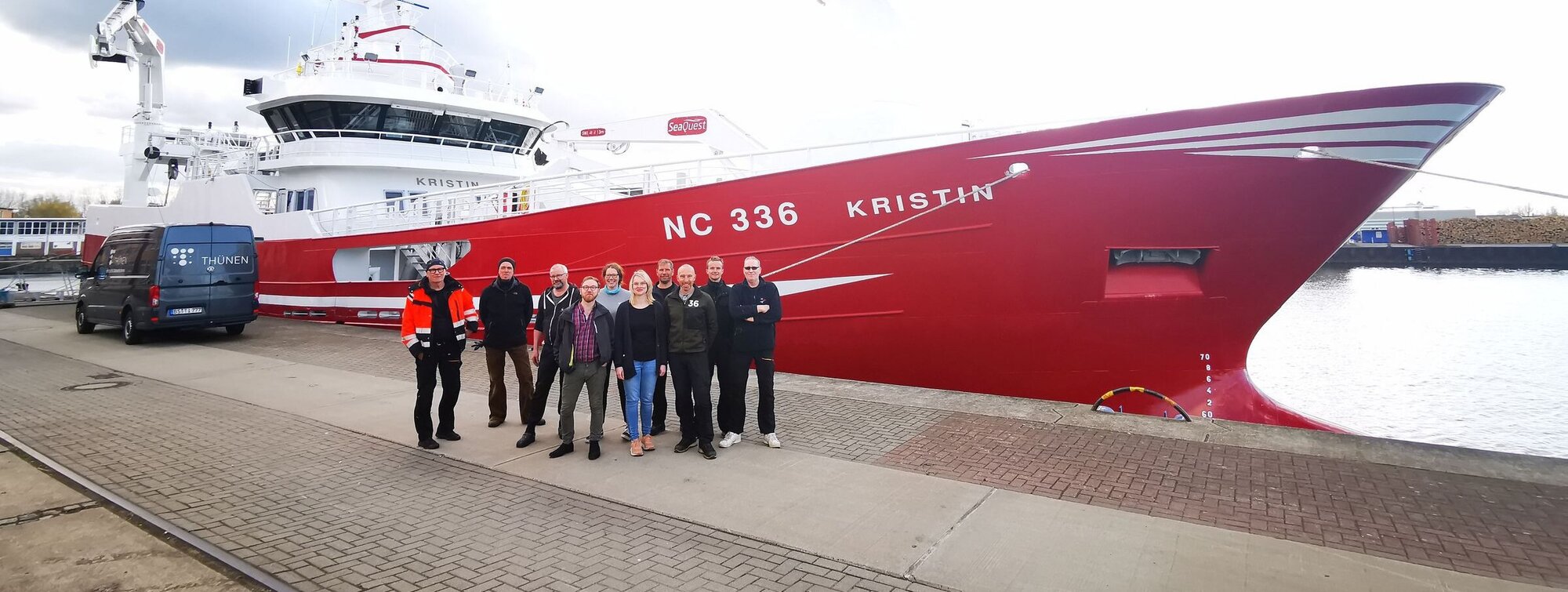
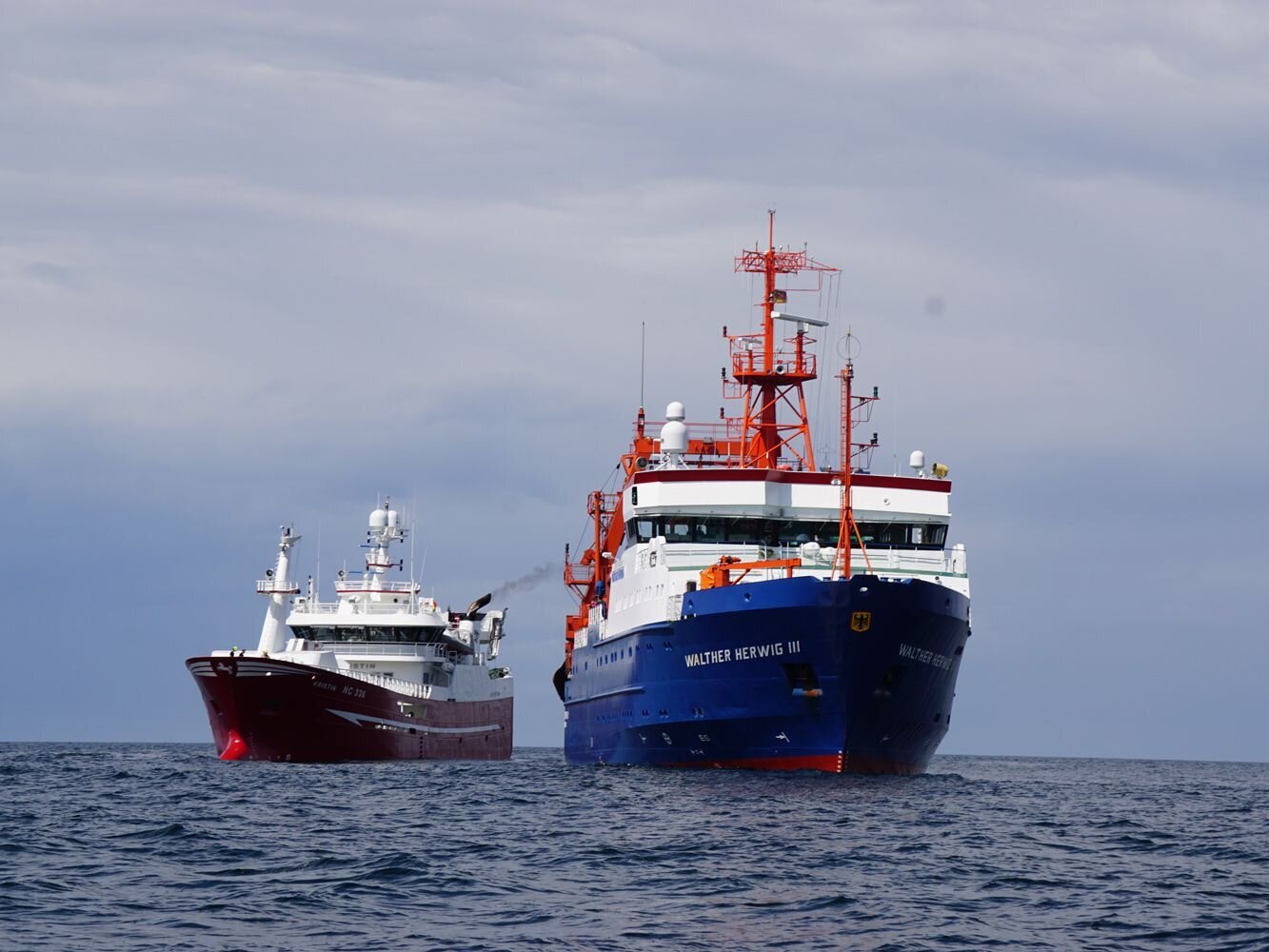
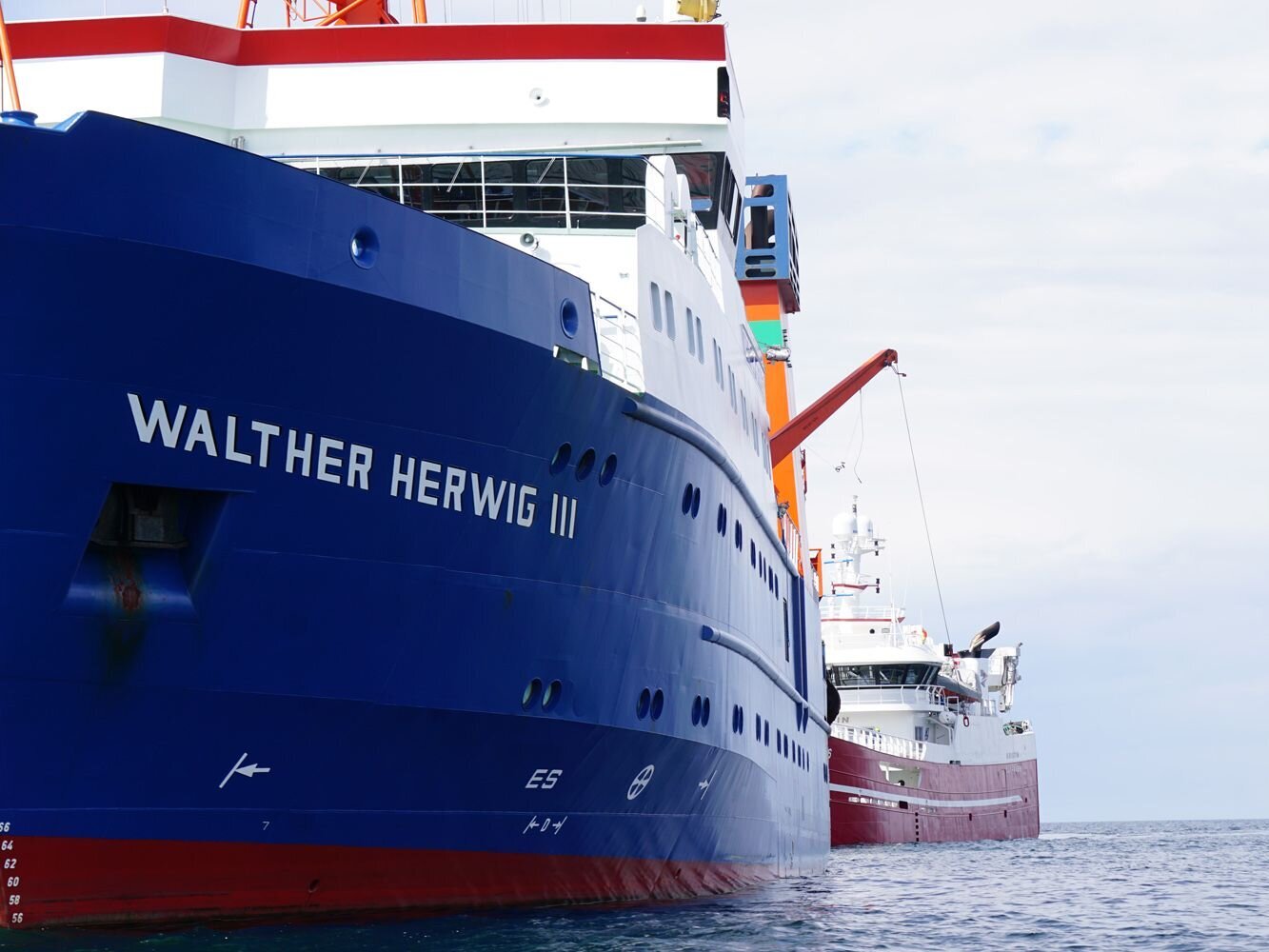
![[Translate to English:] The measured schools of fish from the Walther Herwig III with the Kristin as the leading vessel in the foreground.](/media/_processed_/2/f/csm_IC2_k_fad2c3d952.jpg)
![The Kristin at the pier in Skagen. The commercial shoal fishing vessel is about 10 m shorter than the Walther Herwig III, but highly modern. [Translate to English:] Das Schiff liegt im Hafen von Skagen](/media/_processed_/3/9/csm_KRI_skagen_a_0c03d91088.jpg)
